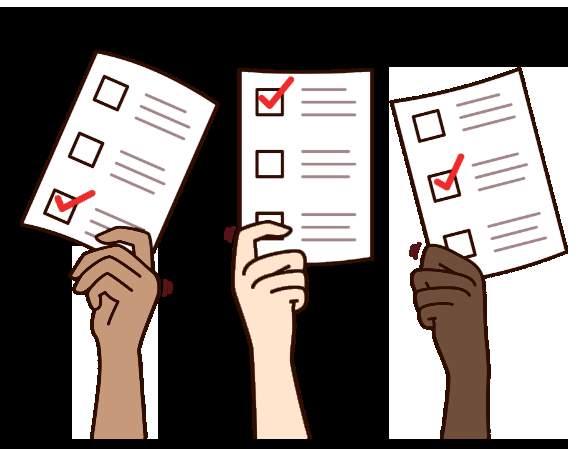Observer




By SAM BRACY News Editor
Tuesday’s presidential election matched pollsters’ repeated predictions for a close race, with crucial swing states set to determine whether Vice President Kamala Harris or Former President Donald Trump will come out on top.
As of 1 a.m. Wednesday, Trump was poised to secure the entire Southeast, including Georgia’s coveted 16 electoral votes, according to the AP. Harris’s path
to 270 electoral votes then narrowed to Pennsylvania and some combination of Michigan, Wisconsin, Arizona and Nevada. If reelected, Trump has campaigned on promises to initiate the mass deportation of undocumented immigrants and high tariffs on imports. Associate Professor of Political Science Christina Greer expected that a second Trump term would be characterized by authoritarianism, especially if judicial and legislative branches of the Federal government fail to apply checks and
balances on the executive branch.
“This time around, it’s very different, because if he chooses to use executive orders, the Supreme Court is essentially stuffed as his supreme court, so you don’t have those guardrails. Or if he tries to do things legislatively, he has a possibly unified government,” Greer said.
The race was at times highly unorthodox. Trump became the first former president to be convicted of a felony in May. Harris ran an unusually truncated threeand-a-half month campaign after
she became the presumptive Democratic nominee when President Joe Biden suspended his reelection campaign on July 21.
In New York, AP projected Constitutional Amendment NY-1 to pass, expanding state equal rights protections to reproductive healthcare including abortions. In the city Charter Amendments NYC-2, 3 and 4 were projected by the New York Times to pass in a victory for Mayor Eric Adams’ administration.
Charter Amendment NYC-2 will empower the Department
of Sanitation, and Amendments NYC-3 and NYC-4 require the City Council to submit budget and public safety legislation with more time prior to voting.
The amendments were opposed by many City Council members under the banner “No Power Grab NYC.” Associate Professor of Political Science Zein Murib said the amendments strengthened the mayor at the City Council’s expense.
“It is giving Mayor Adams more power over City Council proceedings,” Murib said.
By CORA COST
Asst. Sports & Health Editor
Fordham water polo is the lone undefeated team in the NCAA with a 24-0 record and stands tied as second in the nation.
In the pool, Fordham water polo is unstoppable and has yet to face an opponent that matches their precision and ability.
On Oct. 27, the Rams wrapped up a perfect sweep out west at the Julian Fraser Memorial Tournament. The team faced University of the Pacific, University of California-Merced, and The Air Force Academy in San Jose, California, and finished the trip 6-0.
The team arrived in California ranked fifth in the nation and returned to New York City ranked second, tied with Stanford University and University of Southern California. The only team to score higher was University of California, Los Angeles.
The stars of the weekend featured two first-year players: Luca Provenziani, Fordham College at Rose Hill (FCRH) ’28, and Andras Toth, Gabelli School of Business at Rose Hill (GSBRH) ’28.
Following their powerful performances out west, Provenziani earned the Mid-Atlantic Water
Polo Conference (MAWPC) player of the week and Toth was titled co-rookie of the week.
The youthful talent on the roster has an experienced presence that mirrors the veteran skill of their team leaders.
This year’s roster has eight senior athletes, many of whom have been playing together since their first year. Head Water Polo Coach Brian Bacharach believes the leadership from this group has aided the team through their undefeated season.
“That core group of seniors have been together for a longtime. They have been through a lot together. They know the ropes of what it takes to be successful over a multi-month period of time and now a multi-year period of time,” Bacharach said.
Mark Katsev, GSBRH ’25, an attacker for the team, said that the core group of seniors have led the team’s drive for success.
“We are a big group of seniors so we have a lot of leadership. We know this is our last chance and we are super happy, but at the same time we want more,” Katsev said.
Despite their perfect season so far, the Rams are hungry for the first place slot.
By ARIANNA PINNA Staff Writer
McMahon Hall experienced a full water shut-off on Saturday, Oct. 26 due to an overflowing shower. Students and facilities operations shared different accounts on how long the water shut-off lasted and facilities operations shared conflicting stories.
According to Jedd Applebaum, chief engineer and associate director of facilities operations, the shut-off lasted 30 minutes sometime between 1 p.m. to 2 p.m. It was announced in advance via the intercom as well as once the water was put back on.
Applebaum explained the shut-down occurred due to a suspected leak in the pipes which turned out to be an overflowing shower. The overflowing shower had leaked into the kitchen and then into the walls.
“To be on the safe side and prevent further damage, we had to shut it off,” Applebaum said.
Applebaum said the only damage from the leak was to some ceiling tiles which were quickly replaced.
Students living in McMahon described a different story than Applebaum. Kasey Orava, Fordham College at Lincoln Center (FCLC) ’25, and Kennedy Bellin, FCLC ’26, both claimed the water

was shut off for a couple hours. Orava expressed frustration with the lack of communication with residents about the shut-off,
as she was off-campus at the time of the intercom announcement.
By MACKENZIE COOPER Asst. News Editor
Fordham Campus Ministry organized resident assistants to walk students to polling locations to facilitate voting in Tuesday’s presidential election.
Campus Ministry worked closely with The League of Women Voters for New York City, an organization dedicated to promoting political engagement.
Anaisa Gorbea, Fordham College at Lincoln Center ’27, is one of the student volunteers working closely with The League of Women Voters for New York City to encourage members of the Fordham community to vote.
“I volunteered with the League of Women Voters for New York City and the campus ministry was involved with that. So after working the table in the plaza this past week, we just helped volunteers to then walk students over,” Gorbea said.
Yolanda Bansah, FCLC ’28, a Fordham student poll worker at a location near campus during Tuesday’s general election, said she wanted to share her opinion on why voting matters.
“I’m voting because at first I was thinking like, ‘oh, I’m just one person. My vote doesn’t make a difference.’ But
then I realized if everybody else is thinking that then we're just going to have a situation where not enough people are voting,” Bansah said.
Bansah emphasized the value of voting in a community-oriented environment, highlighting how such a setting can inspire greater civic participation.
“I think it’s really good because I just feel like people really need to understand the importance of voting and doing it in a group setting. I feel like it really encourages you to get out and vote and I don’t, yeah, regardless of who you’re voting for, it’s really important to vote,” Bansah said.
In the months prior to election day, Fordham held tables and allowed posters on campus encouraging students to register to vote. At a press conference with student newspapers, University President Tania Tetlow emphasized the school’s commitment to political participation..
“I am hoping that we can hit as close to 100% voter turnout as possible,” she said.
Campus Ministry facilitated student voting, which supported Tetlow’s wish and reinforced the University’s history of encouraging students to participate in democracy.
By ALISON BEINHAUR News Editor
Fordham Lincoln Center students sent mail-in ballots back to their home states to vote in the presidential election and local races.
Voters requested 67 million absentee ballots ahead of this year’s election according to the New York Times, accounting for a third of registered voters.
The dates to register for mail-in ballots, the deadlines by which they must be sent and the requirements for voters to be eligible to vote by mail vary from state-to-state.
In some states, including New York, all eligible voters can request an absentee ballot without requiring a specific reason why they cannot vote on election day. Connecticut and other states stipulate that voters meet requirements to receive an absentee ballot. Some of these specifications include physical disabilities, military status or absence on election day.
Nicole Knowles, FCLC ’28, was worried about the status of her ballot. As a first-time voter from New Hampshire, Knowles wanted
to ensure that her ballot was received and counted, but was worried that there would be complications in transit.
“On social media you see people, especially from farther away states, that something happens and their ballot gets lost in the mail or it doesn’t get back in time,” Knowles said.
Students such as Elise Jackson, FCLC ’27, never received their mail-in ballot. Jackson is registered to vote in Texas and her request to vote by mail was approved on Oct. 17, but was canceled because of an issue. While she reissued her request a week prior to election day, her ballot did not arrive at her on-campus address.
“I have called many times, and they say it has been sent, but I have gotten no ballot,” Jackson said.
For Jackson, approval for a mail-in ballot was an uphill battle.
“Texas is very strict with mail-ins. Specifically for students, you really need to either be in the hospital or active military to be guaranteed a ballot, and so I was very surprised whenever I was granted a ballot even though I am not one of those things,” Jackson said.
Most states required mail-in ballots to be due on Nov. 5.

By PARIS MATHUKU Asst. News Editor
On the third floor of Keating Hall at the Rose Hill Campus, Fordham University’s Democratic Club, or Fordham Dems, hosted a Nov. 5 election watch party. The event drew students eager to follow the election results as states were called.
Some students said they felt calmer around like-minded people.When a state was called in favor of the Democrats, the room erupted with students cheering, clapping and jumping in celebration. When a state turned red, students laughed and booed playfully, emphasizing the camaraderie.
“College students are a huge part of the electorate,” Dan Sponseller, Fordham College at Rose Hill (FCRH) ’25 and president of the Fordham Dems, said. “Our voices matter, and events like this give people a way to feel involved and stay informed.”
He said that there have been voter registration drives and discussion sessions to encourage political engagement.
The club’s treasurer, Kyle Zingler, FCRH ’26, said that gatherings like this are a way to feel community on campus.
“Getting people together to watch results builds camaraderie,” he said. “We’re watching TV, but we’re also talking about what it means to vote and what the results mean for us.”
Zingler added that the club aimed to make politics accessible to students who might be less educated or aware of the issues at stake.
Stephanie Lopez, FCRH ’26, said that she feels there is a broader significance to the 2024 elections.
“It’s not just about one party or the other,” she said. “It’s about holding our representatives accountable and seeing if they really support the issues we care about — like climate action, healthcare, and education.”
According to Lopez, a deep and thorough understanding of governance at an early age is especially important for civic participation throughout one’s life.
“Regardless of who wins, we have to keep pushing for change,” Sponseller said. “That’s what being part of a democracy means.”
The Fordham College Republicans said that they held a watch party off-campus. At the time of publication, they had not provided comments or photos.
By MICHELLE WILSON Asst. News Editor
The halls and Outdoor Plaza of Fordham Lincoln Center appeared deserted on Tuesday with a closed university. Instead, students were huddled around laptops or glued to TVs as they awaited the election results.
Supporters of Vice President Kamala Harris expressed anxiety as immediate returns squashed some hopes of a decisive Democratic victory on election night. Mia Paolicelli, Fordham College at Lincoln Center (FCLC) ’28, said she is fearful that reelection for Donald Trump would imperil protections on reproductive healthcare.
“I’m scared for my rights as a woman in America,” Paolicelli said.“Obviously I want Harris to win because of her stances on reproductive rights, gun control, climate change… I just think that she leads a more hopeful future for America.” Johnny DiLorenzo, FCLC ’28, expressed his reaction to the callings around 11p.m.
“It’s disappointing, to say the least, but it’s definitely still too close to call,” DiLorenzo said.
Ethan Mai, FCLC ’28, voted for Trump. He said he is excited for the future, regardless of the election results.
“I’m feeling great,” Mai said. “Just go America, that’s it. No matter, whichever way the results turn out, go America.” Mai continued on Ukrainian and Palestinian conflicts, and his stance on border control.
“I think Trump is definitely a worse person, but I’m focused on foreign affairs, especially the ongoing wars and stuff and I just feel more confident in Trump’s ability to get something done,” Mai said.
Tipton-Nigro said her decision to vote for Harris was shaped by more than just a fear of Trump.
“I think that her being elected would be a great moment of change in America where more women can take on leadership positions, and also more people of color can enter into politics. So I'm just really optimistic that she will usher in a new political era for us,” Tipton-Nigro said.
Students on both sides of the politicial spectrum anxiously await results that will continue to come in during the upcoming days and shape the country's future.
By VERA ILIADI AND ELENA DIMITRIOU Contributing Writers
When one student first moved to the United States to attend Fordham University, she found out firsthand the vast economic difference between the U.S. and her native country, Vietnam.
“Going out to have a banana or have some bread costs as much as a whole meal back in our home country,” Linh Hoang, Gabelli School of Business at Lincoln Center (GSBLC) ’28, said.
Economic concerns like Hoang’s are a major issue in this presidential election. In the Vice Presidential Debate on Oct. 1, CBS News Anchor Norah O’Donnell asked Governor Tim Walz if Harris’ economic plan will work without increasing “the nation’s deficit by 1.2 trillion dollars.”
“ I may have to choose between working extra hours,” Hoang said.
“Or focusing on my studies.”
Linh Hoang, GSBLC ’28
Hoang said she can see how rising prices could personally impact her. “I may have to choose between working extra hours,” Hoang said. “Or focusing on my studies.”
Like many other international students, Hoang does not have the ability to cast a vote for who will be in charge of her future in the U.S. — despite the implementation of future policies that could affect her directly.
Almost 15% of Fordham
students chime in on an atmosphere of rising tension and concern
University’s 17,000 students are international students — and they often echo a unique urgency on political matters. In this shared space on campus, the contrast is stark: Domestic students are driven by their visions for a promising future, while international students navigate an intricate landscape of uncertainty, their hopes entwined with outcomes decided by others.
As Fordham’s campuses buzz about the upcoming election, these students — who come from every corner of the globe — are aware of the stakes involved. Reflecting the political anxiety of some U.S. citizens, international students said that this election raises concerns about their hopes and fears for an uncertain future.
Studying abroad in the U.S. is a complicated process for many international students. First, students must be accepted to a university, then apply for the Student Exchange Visitor Program (SEVP), a program within The Department of Homeland Security (DHS). The SEVP manages the students trying to obtain an F visa, commonly referred to as a “student visa.”
An interview process comes next. It often includes a sit-down meeting with the U.S. embassy in the student’s country of origin. They answer questions regarding their school of choice, how long they want to stay in the U.S., and whether the student meets “the requirements under U.S. law to receive a visa,” as phrased by the Department of State.
After this lengthy process, international students also face a lack of opportunities when it comes to the work environment because of the difficulty of obtaining a work-visa post-graduation.
One Forbes immigration reporter argued that Donald Trump, if reelected, can be expected to
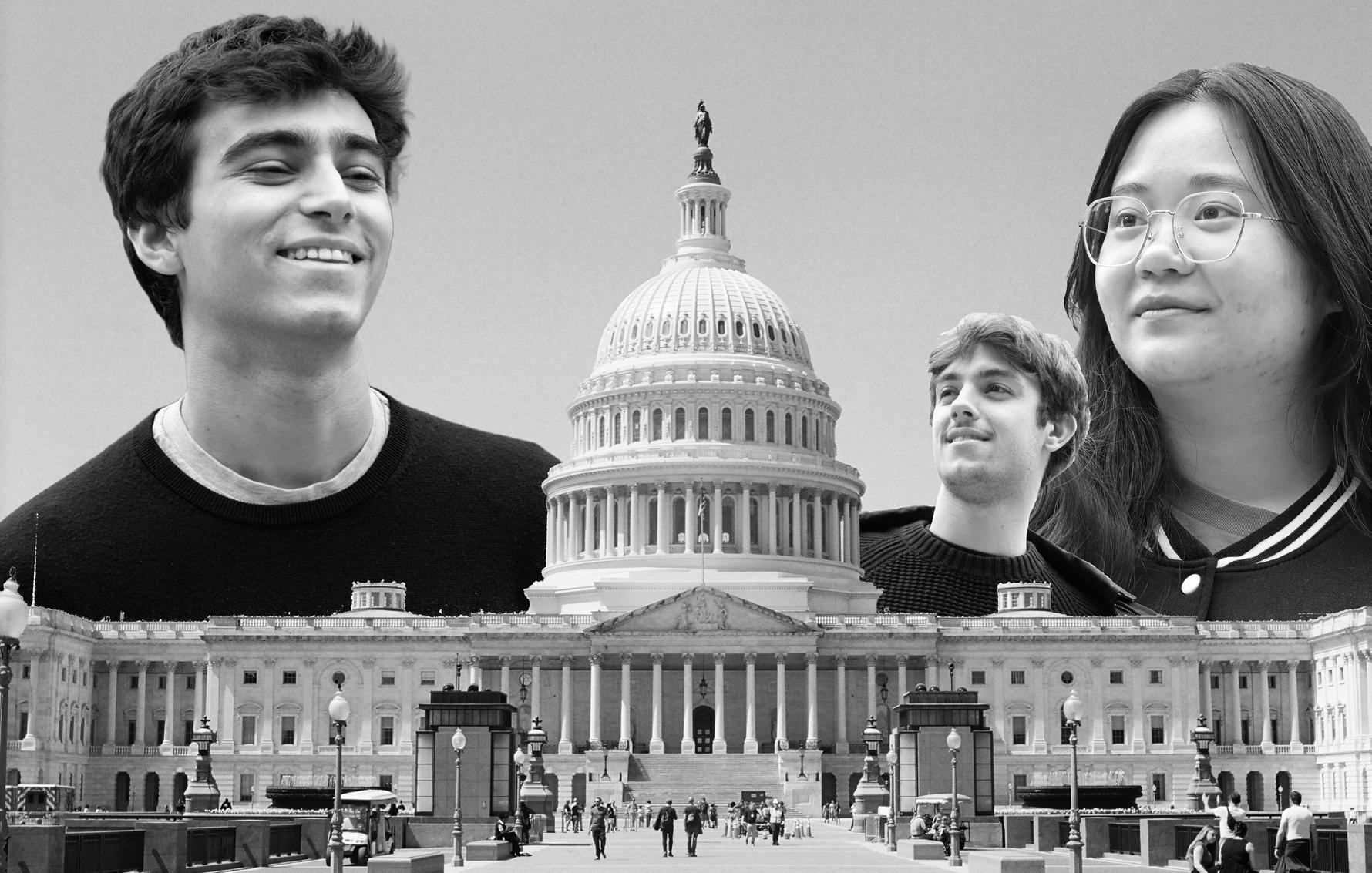
restrict employment-based visas.
Records from the DHS in 2022 show that under the Trump administration, the amount of new Legal Permanent Residents in the U.S. decreased. In the most recent available data from the DHS, the amount of new greencard holders has increased under the Joe Biden administration.
One of the many focuses on Kamala Harris’ campaign is border and immigration control. Her website states that the “immigration system is broken and needs comprehensive reform that includes strong border security and an earned pathway to citizenship.”
Regardless of the range of policies some international students are not planning to seek permanent residency status. Nastasia

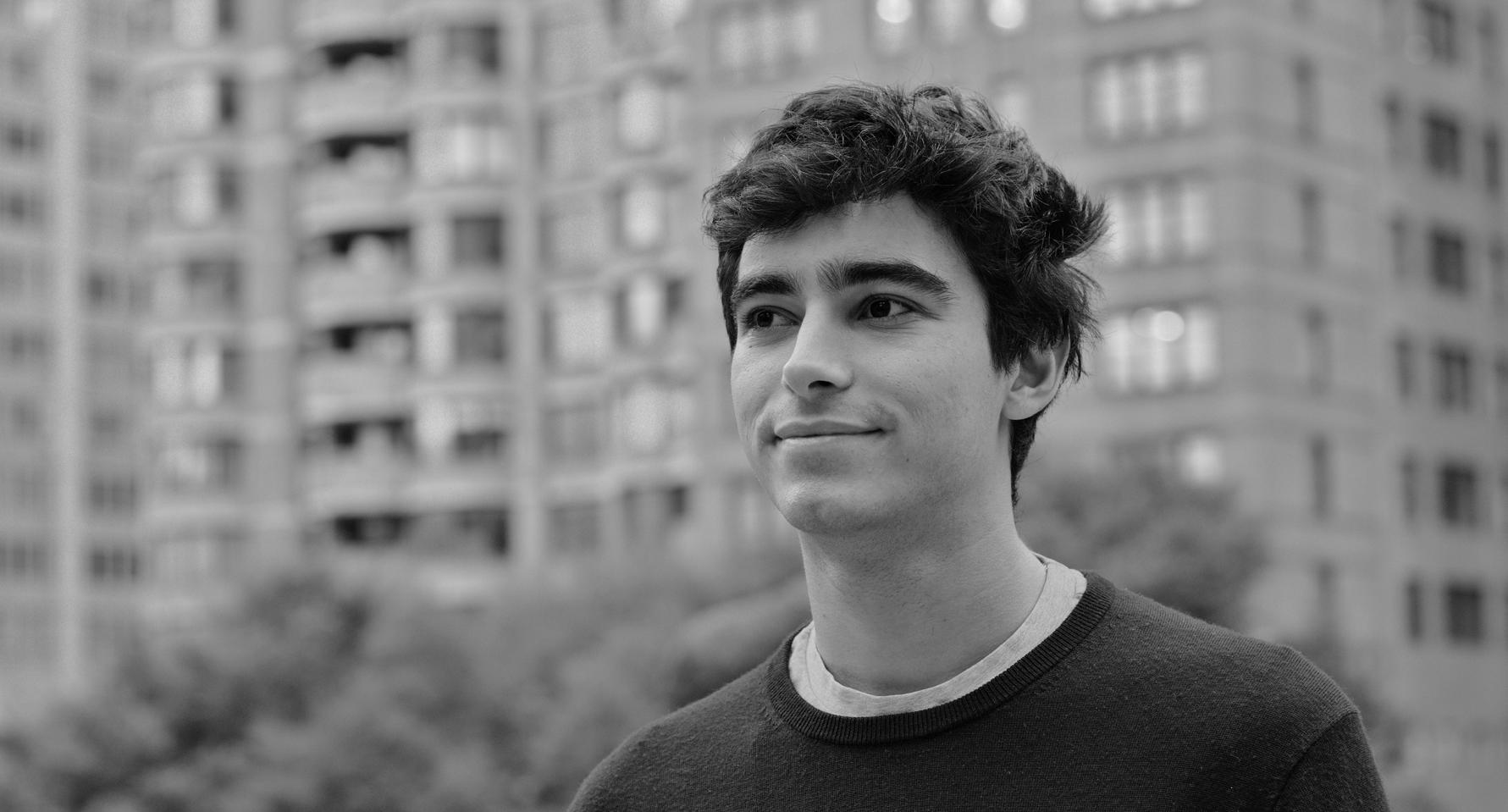
Baic, Fordham College at Lincoln Center ’28, a student from Serbia, is one of them. Baic said that her post-graduation plans also shape how she thinks about immigration.
“I feel that everyone should be allowed to come into the country legally,” Baic said. However, she said she believes that “they need to be regulated to live as citizens.”
Regardless of different policies between the two major parties, both domestic and international media outlets have said this political era has seen a proliferation of polarization and prejudiced rhetoric.
One writer for The Guardian wrote that Trump’s message “amplifies existing xenophobic beliefs within the American psyche as a means of political gain.”
A report from NBC News in 2023 states that “it’s undeniable that the United States has become more politically polarized than it was a decade ago — as well as a decade before that.” The political divide in the U.S. has been growing leading to a dramatic split in the approval rates of the U.S. presidents. In 1948, before Truman ran for a full term, his approval from the Democrats was 68% and from Republicans 50%.
During Biden’s 2020 Presidency, 72 years later, the political climate was vastly different with only 6% of Republican approval and 83% of Democrat.
When it comes to the legislature, Pew Research Center has found that Democrats and Republicans in Congress, on average “are farther apart ideologically today than at any time in the past 50 years.”
And Americans, too, have seen polarization play out in a different way. “Despite agreeing on much,” The Economist reported in 2021 that,“Americans dislike each other more than ever.”
Despite New York City’s status as one of the most diverse cities in the world, racism is still present and often felt by international students. Om Madhavi, GSBLC ’28, an international student from India, expressed his concerns regarding his safety in the city.
“Because of the election rhetoric, people might have different perceptions towards international students, sometimes being more discriminatory,” Madhavi said. Whenever he ventures off campus, “I might experience some form of discrimination — which I’m a bit scared of,” Madhavi said.
Another international student, Alejandra Velascoc, GSBLC ’28, explained that this high-tension
atmosphere impacted how she behaves in public as well.
“I have to be more conscious of my environment and what I’m doing and how I’m behaving, even if I’m not doing anything wrong, because of the fear of possibly getting into trouble and getting my student visa revoked,” Velascoc said.
Stephen Danev, GSBLC ’28, a student originally from Canada said he follows the election with fascination without carrying much concern for what it entails.
“I’m very excited to see how it all turns out. It seems to be very interesting. I feel for international students, it’s not as real as it is for the Americans because it doesn’t affect us in the same way it affects them,” Danev said.
Can Metin, GSBLC ’27, who is originally from Turkey, but grew up in the Netherlands, said he’s mostly interested in the impact this election will have on the rest of the world.
“I am quite intrigued to see the outcome and the potential socioeconomic effects that it could have,” Metin said. “It’s really interesting to see that a lot of my American friends are very much engaged with the election itself.”
While many Americans focus on the effects of the election by analyzing mostly domestic policies, some international students are aware that U.S. foreign policy has a major impact on political affairs worldwide.
International students live under the daunting tension of not being able to vote in the country in which they reside.
International students live under the daunting tension of not being able to vote in the country in which they reside. Students like Hoang said they listen intently to their peers when discussing their voting plans — all with the knowledge that they themselves cannot cast a ballot.
“It would definitely affect us. We don’t have a say on who would win the election or what policies would be implemented on our immigration status,” Hoang said. “It definitely worries us.”
Despite their ineligibility to vote, some international students experience the same stakes as their domestic peers — and will be watching the election just as intently.
Students and facilities operations share conflicting accounts of water issues in dorm building
LEAKY DORM from page 1
“I was most frustrated that I didn’t receive an announcement by email or from my RA when I was coming home because it’s possible I would’ve changed my plans that day a little bit had I known the water was going to be off,” Orava said.
Following the reinstatement of the water, Orava said the water was coming out brown for a couple minutes.
“It was not the most pleasant to look at, but it did eventually get better,” she said.
Water-related problems in the dorms are no stranger to Bellin, who said her bathroom has not had reliable hot water in over a month.
“ Hot showers are starting to feel like a gift from God.”
Kennedy Bellin, FCLC ’26
“Hot showers are starting to feel like a gift from God.” she said. “Last night my shower was so cold I was shivering.”
Orava said she faced similar issues with consistent water temperature.
“We’ve been finding that when we shower, sometimes the water doesn’t get hot enough and we have to take cold showers,” Orava said.
Phia Funicello (FCLC ’27) said she had problems with the water temperature from move-in day.
She said that hot shower reliability has been “disappointing

from the start.”
Funicello went on to describe a leaky toilet, mold in clusters around the bathroom, and her shower ceiling which fills up with water every time she and her roommates take a shower. She said that Facilities Operations hasn’t responded to the work order she placed concerning the drooping shower ceiling.
In response to water heater issues, Applebaum said that there was an issue with the pump which was repaired the night of Oct. 30.
“Since Wednesday, the water has been steady and constant,” he said.
Applebaum explained future plans to create back-up solutions
so there could be abundant hot water.
McMahon faced another leak on Oct. 30 at the entrance of McMahon in front of the Office of Residential Life. According to facilities operations, the leak was caused by a problem with a drain valve connected to an air conditioner, a problem that typically occurs when switching from cooling to heating. Orava and Bellin both reported seeing water dripping from the ceiling and creating a puddle on the floor.
Applebaum ensured there was nothing to worry about.
“It looked a lot worse than it actually was,” he said.
Water-related problems aren’t
the only problems students have faced with the facilities at McMahon.
Bellin expressed frustration with the quality of the facilities at McMahon and the more than $20,000 price she paid for nine months.
Bellin reported her and her friends experiencing issues with brown grease stains on their clothes from the washing
machines. Despite two work orders, Bellin said the issues have not been fixed.
Bellin expressed frustration with the quality of the facilities at McMahon and the more than $20,000 price she paid for nine months.
“I feel like I’m paying an insane amount to live on campus to be dealing with this,” Bellin said.
Funicello expressed similar complaints surrounding the price of the dorms and the quality of living she’s getting in return.
“For the amount of money I’m paying to live here right now, I can handle everything else, I can handle a leaky toilet, I can handle water damage, I can handle not amazing water pressure, all I ask for is a hot shower,” she said.
There have been other plumbing incidents in past years, such as a collapsed ceiling in September 2019. It stemmed from a clogged mainline connecting all running water appliances which led to a pipe bursting.
When reminded of the incident, Applebaum stressed the facilities department’s emphasis on swift action.
“We do have problems, risers get clogged, pipes get clogged, but we really strive to be more responsible than an apartment building. We have people 24 hours a day, seven days a week to make sure we respond quickly,” Applebaum said.
Despite these efforts, student complaints surrounding water temperature, general facility upkeep, and communication from maintenance persist as residents said they feel a substantial disparity between the cost of residence halls and the quality of life that they experience.
By PARIS MATHUKU Assistant News Editor
Ram Hospitality will extend Ram Café’s operating hours until 10 p.m. to accommodate students with late schedules, according to United Student Government at Lincoln Center (USGLC) President Fiona Shehu.
The extended hours will specifically apply to Burger + Fries and “grab n’ go” options, located in Ram Café. Shehu, Fordham College at Lincoln Center (FCLC) ’25, said that extended hours allow students to be relaxed about what time they eat.
“ The facilities committee has been having conversations with Ram Hospitality on how students wanted longer dining hours.”
Fiona Shehu USGLC President
Shehu said USGLC discussed longer dining hours with Ram Hospitality because it was one of the top complaints from students. For some students, dining hours are about more than just convenience.
Students with evening classes, demanding extracurricular activities and off-campus jobs might miss the current 8 p.m. close of Ram Café and Community Dining Hall. Eating off campus or ordering delivery also can create an
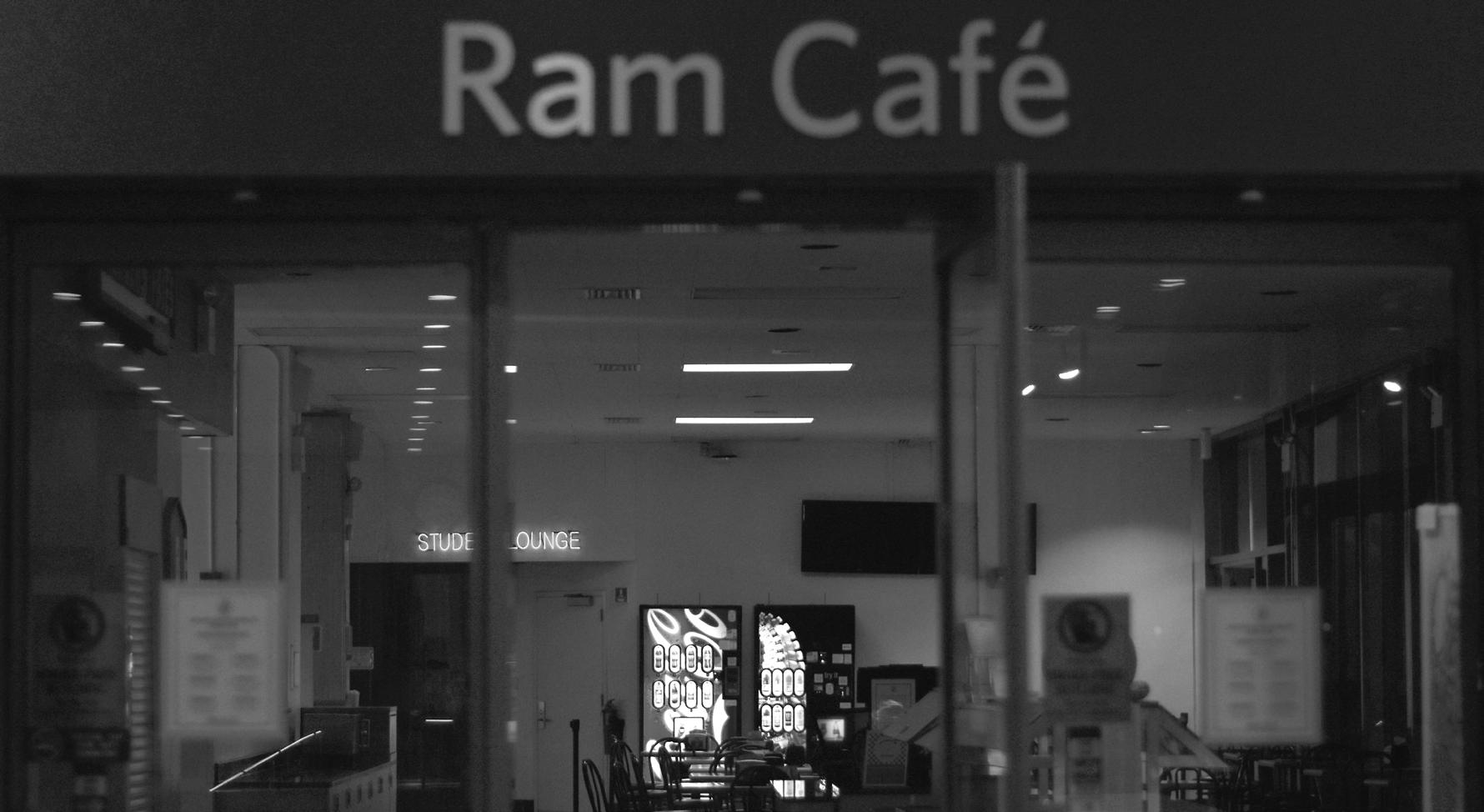
Ram Cafe is to operate longer hours in order to accomodate Lincoln Center students with late night schedules
additional financial strain.
Recognizing these issues, USGLC representatives advocated for extending the operating hours for campus dining centers at Lincoln Center. Shehu said Ram Hospitality worked together with the Facilities Committee and Chair of Facilities, Isabella Casano, FCLC ’24, in order to raise the issue and execute their plans.
“The facilities committee has been having conversations with Ram Hospitality on how students wanted longer dining hours, which USG learned from our general meetings and senators who spoke to the student body,” Shehu wrote. “Through those conversations and Ram Hospitality’s own discussions, they have decided to
extend hours in Ram Café.”
Those concerned about off-campus safety late at night may also be negatively impacted by the 8pm close times. Shehu said that it can be inconvenient to dine off campus late at night, especially for students without easy access to transportation.
“It's just the safety concerns. You know, New York is not necessarily the safest place and as a commuter student, I can attest to that.” Shehu said.
The problem has underscored a gap between the needs of students and the current dining services, leading USGLC to take steps to make dining more accessible.
At the start of the school year, USGLC representatives
immediately began collecting feedback through general meetings and outreach with students. After gathering input from all new and former members, USGLC initiated talks with Fordham’s Board to advocate for a change in the dining hall hours.
While the schedule has not been officially announced at the time of publication, students can expect the new hours to launch soon according to Shehu.
Limited dining hall hours have been a source of frustration for some Fordham students. Natalie Ayoub, FCLC ’28, who resides in Mckeon Hall said that students with evening classes, demanding extracurricular activities or off-campus jobs might miss the
8 p.m. closing time of campus dining.
The lack of late-night food service options on campus has made it difficult for many students like Ayoub to find convenient, inexpensive and healthy dining locations.
The lack of late-night food service options on campus has made it difficult for many students like Ayoub to find convenient, inexpensive and healthy dining locations.
“I personally love the dining hall and I literally just always eat at the dining hall. I don’t go anywhere else. So when it’s closed earlier it makes me have to go somewhere else. It gets very expensive,” Ayoub said.
This collaboration with Ram Hospitality represents a significant step in addressing students’ broader needs on campus.
The decision to extend Ram Café hours was achieved in part through dialogue between the student body and campus administration, mediated by student government. As this priority for USGLC has been realized, student government may continue to be a means for students to voice their needs in an organized, constructive manner.
By MADELEINE BAMFORD Contributing Writer
As a college student, Sophie Lama knows money doesn’t grow on trees — but as a small business owner, she knows money can grow on campus. Lama provides her at-home nail services to students at a discount that rivals many of the salons impacted by inflation.
Lama, Fordham College at Rose Hill (FCRH) ’26, began her nail business during her first year, operating out of McMahon Hall. After she paid $100 for a full set of acrylic nails, she decided to order a beginner kit from Amazon. With a new drill, a few polishes and commitment, Lama launched her Instagram @nailsbylama by converting her unused United Student Government Instagram account (with over 600 Fordham followers) into a page to promote her new small business.
“ I would do it for free because I enjoy doing it so much.”
because she, like Lama, was tired of the cost.
“If there’s something I’m paying for that I can learn to do myself, I learn it,” Sharon said.
As someone pursuing a fashion studies minor, Whitehall creates trendy crochet and knit clothing and accessories for her Instagram, @kimmyskrafting.
Like Lama and Sharon, Ailey/ Fordham BFA student Berisha Fareau, FCLC ’25, operates her braiding and hairstyling business through her Instagram account: @braidsbyberi. Originally, Fareau styled her friends’ hair as a hobby to sharpen her skills and refused offers to charge for her services.
“I would do it for free because I enjoy doing it so much,” Fareau said.
Through @braidsbyberi, Fareau has had the honor of providing some of her customers with their first braids.
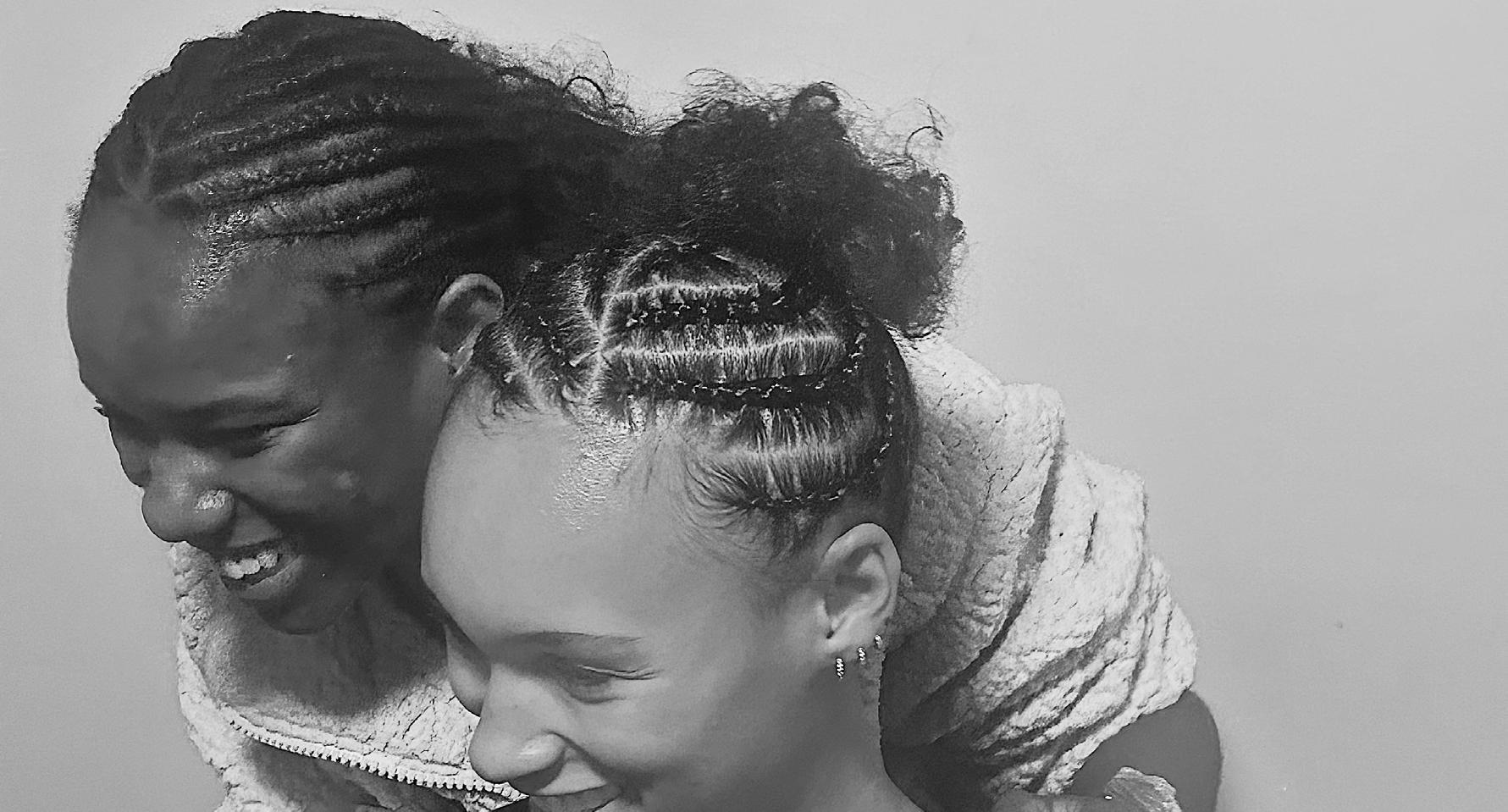
Nail businesses are a trend for Fordham students to earn extra cash and build community.
Former Observer Arts and Culture Assistant Julie Sharon, Fordham College at Lincoln Center (FCLC) ’25, similarly runs a nail business on campus and in the New York City area. She specializes in gel-x manicures and advertises on her business instagram: @julie111nails.
Sharon started doing nails
“It brings them so much confidence; it makes them come into their own. Stuff like that makes me want to continue doing hair,” Fareau said. “I love making people feel good about themselves.”
Fareau’s roommate Kimberly Whitehall, FCLC ’25 and also in the Ailey/Fordham BFA program, began crocheting during the 2020 COVID-19 lockdown and started to receive commissions for the first time after she wore her pieces on campus. As someone pursuing a fashion studies minor,

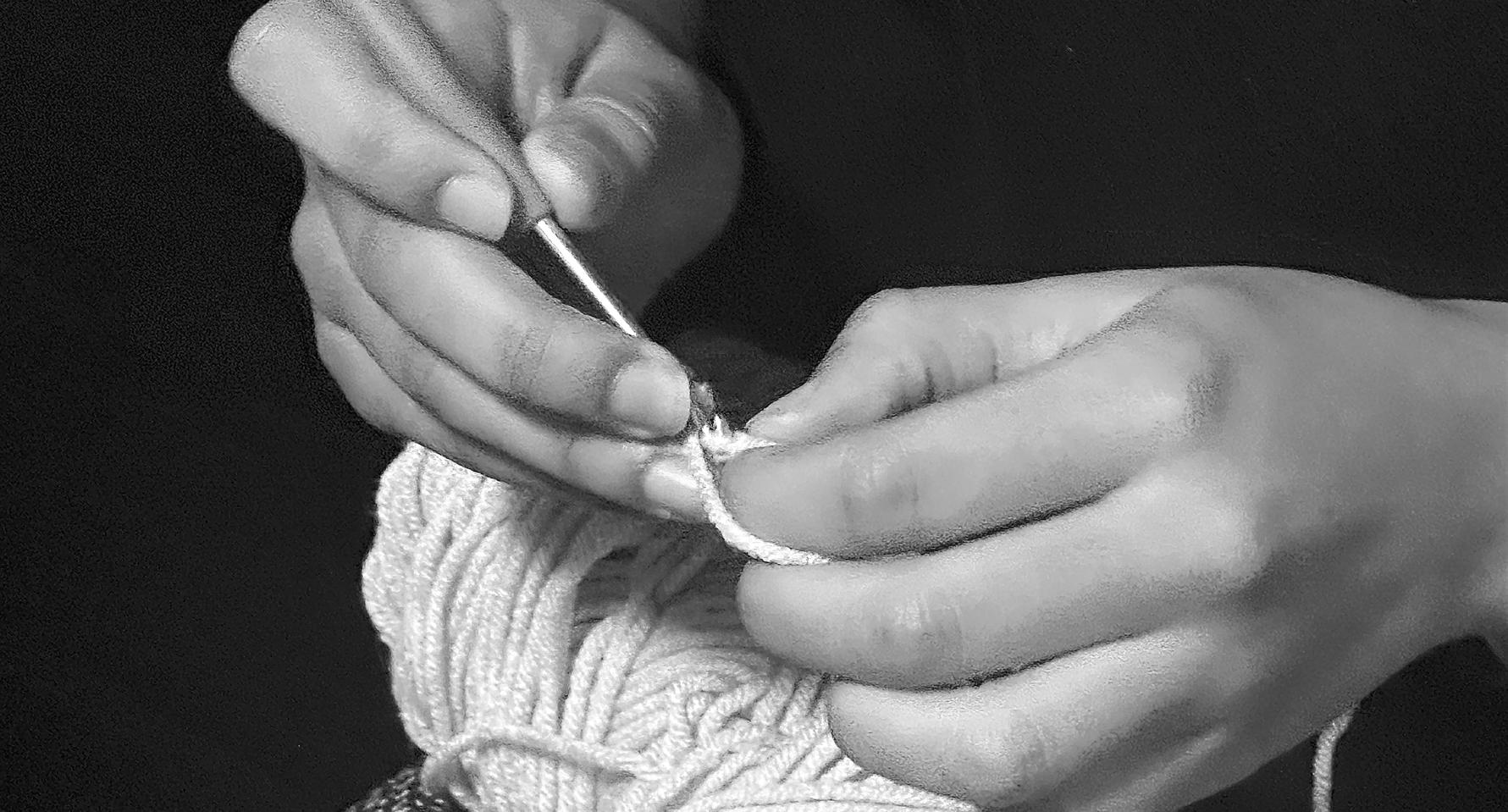

Whitehall creates trendy crochet and knit clothing and accessories for her Instagram, @kimmyskrafting.
As a way to combat the rising prices of life as a college student, Whitehall frequently trades services with Fareau. Whitehall described the difficulty of raising prices.
“The amount I am getting paid is not changing, and prices are the same. How much I am able to save is smaller. It’s hard,” Whitehall said.
Recognizing the growing expenses of groceries, tuition and living in the city, Lama offers a sliding scale to her customers, avoiding extra charges for charms or new designs popularized on social media. She plans on implementing monthly sales on her Instagram for new nail models at a discounted price.
Fareau said that her hair styling business has helped foster community at FCLC.
“ A lot of people have come back — it’s a sign that they like my services and my prices. We help one another.”
“When my friends saw my nails, they would ask where I got them done. Now I have a regular set of clients that I see on a monthly basis,” Sharon said.
“ Doing nails was a great way to meet other friends, earn money and explore my hobby in nail art. ”
Similar to her contemporary student entrepreneurs, Fareau found personal and community fulfillment through the seemingly simple act of braiding. For her, money earned is secondary to her community connection.
After Lama established a customer base at FCLC, she decided to transfer to FCRH. An intercampus transfer can be difficult, especially for a sophomore with an existing group of friends. Lama used her nail business to connect with new FCRH clients while retaining her previous business model to help them save money.
“I wasn’t familiar with anyone on campus. Doing nails was a great way to meet other friends, earn money and explore my hobby in nail art,” Lama said.
“A lot of people have come back — it’s a sign that they like my services and my prices. We help one another,” Fareau said. For Sharon’s nail business, the customer base started with just her friends, but due to popular demand her clientele quickly expanded.
Fareau, Whitehall and Lama aim to make their services pleasurable, convenient and competitively priced.
“I don’t want it to be a situation where someone can’t afford it,” Lama said. “I want you to leave happy with your price and nails. Look good, feel good!”
Stevie Fusco contributed addi-
reporting to
The Fordham men’s basketball team took down the Retrievers 86-72 in a competitive exhibition game
By WINSON ZHENG
Asst. Sports & Health Editor
The Fordham men’s basketball (MBB) team defeated the University of Maryland-Baltimore County (UMBC) Retrievers 86-72 in a hard-fought exhibition game on Oct. 27. The showcase revealed the Rams’ offensive firepower and potential for the upcoming season.
The Rams — the 12th seed in the Atlantic 10 Conference last year — were eager to claim a hard-earned victory against the Retrievers — the seventh seed in the America East Conference last year.
This game was the second exhibition game of the season and does not affect either team’s season record. However, both teams came out with intensity, bringing their competitive energy to the court and battling down to the wire.
After the win, Head Coach Keith Urgo said that the exhibition game is important to the team’s in-season progression.
“(Exhibition games are) legitimate real games — the way we play, the way we substituted, the way we defend — we were playing as if these games count,” Urgo said.
Heading into the new season, the Rams welcome back most of their key players from last year.
Guards Japhet Medor, Gabelli Graduate School of Business (GGSB) ’25; Will Richardson, Fordham College at Rose Hill (FCRH) ’26; Zach Riley, FCRH ’25; and forward Joshua Rivera, FCRH ’26, are among those returning.
There are also promising new additions to the roster that include two transfer players: Matt Zona, GGSB ’25, out of Notre Dame, and guard Jackie Johnson III, FCRH ’25, who played for the University of Nevada, Las Vegas. Both players add depth and experience to the lineup.
The Rams also introduced a talented freshman class, headlined by three-star recruit Jaden Smith, FCRH ’28, one of the highest rated recruits in Fordham MBB history.
The starting lineup included Medor, Zona, Richardson, Johnson and Romad Dean, FCRH ’26.
The Rams won the tipoff, but struggled to find their rhythm early. While both teams played with high intensity, the Rams
were scoreless almost four minutes into the game. Their struggles were compounded by poor rebounding, allowing the Retrievers to score most of their early buckets from offensive rebounds.
“ We were giving up way too many drives in the paint and obviously way too many secondchance points. ”
According to Urgo, these early lapses emphasized areas that need improvement as the season progresses.
“We were giving up way too many drives in the paint and obviously way too many second-chance points,” Urgo said.
Despite the slow start, the Rams stayed composed. A few possessions after coming out of a timeout, Johnson dribbled the ball up the court and attacked the lane to drain a midrange jumper.
Following their first few baskets, the Rams started to slowly gain momentum. Johnson went on a 4-0 run and followed up with a quick steal and layup to tie the game at 7-7.
UMBC responded with a strong offensive push. The Retrievers scored two consecutive baskets and Ace Valentine, UMBC ’27, drained a 3-pointer, preventing Fordham from taking the lead.
Nonetheless, halfway into the first half, Johnson attacked the lane aggressively, laying in an impressive, high-arcing layup that gave the Rams their first lead at 20-19.
Fordham began to hit their stride. Richardson and Johnson made back to back buckets totaling 11 points to give Fordham an 8 point lead, the highest thus far with only five minutes remaining in the first half.
The Retrievers countered by exploiting Fordham’s rebounding issues, attacking the paint and drawing fouls. Their focus on inside scoring and free throws allowed UMBC to trim the Rams’ lead to seven at 46-39 at the end of the half.
Despite the challenge on the

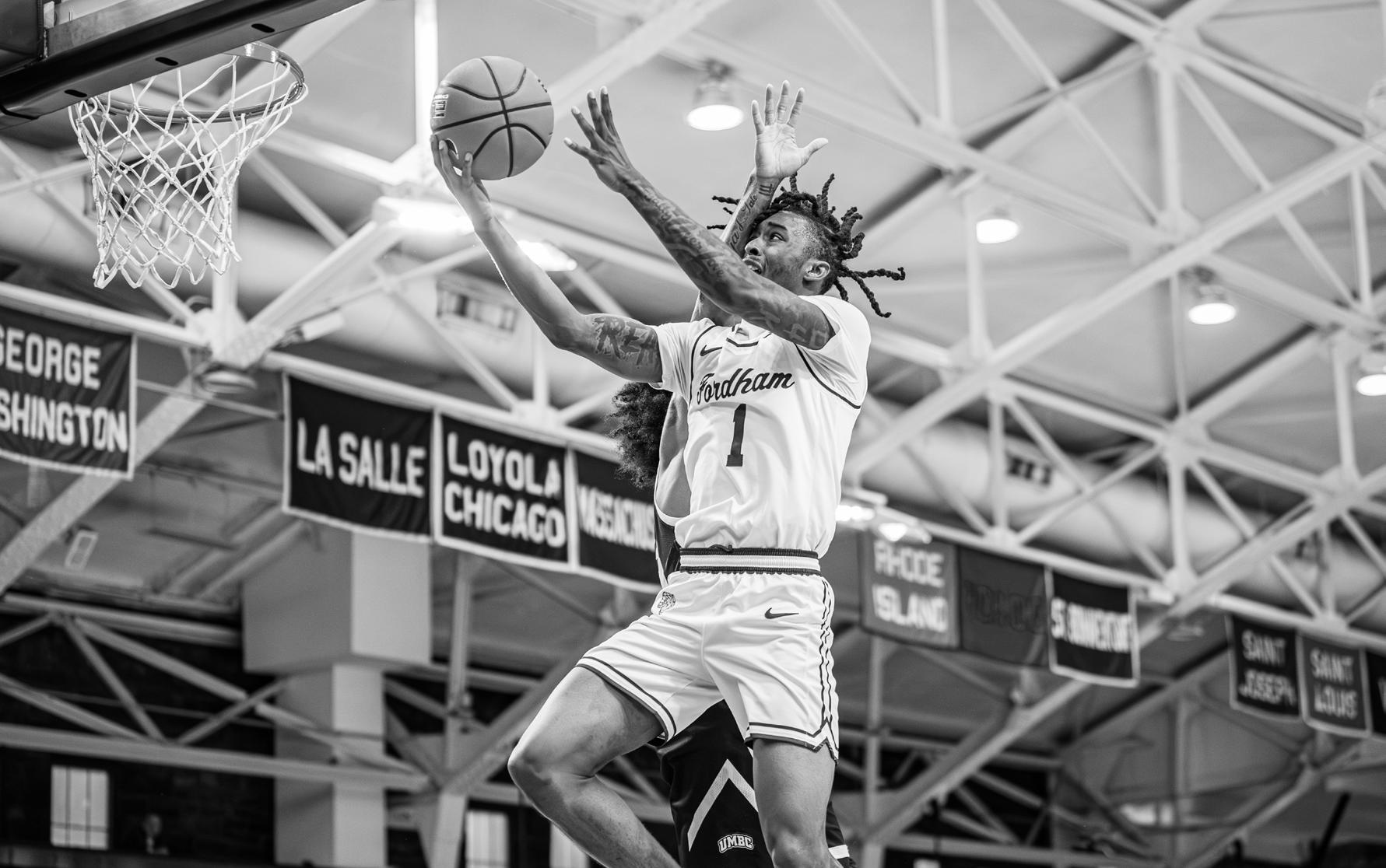
boards, Fordham displayed resilience in other areas of the game.
The Rams entered halftime with impressive shooting stats, having higher percentages in field goals made as well as 3-point shooting. However, their struggles on the boards were evident, as they were out-rebounded 18-12, which contributed to a deficit in points in the paint, trailing 24-18 in that category.
Entering the second half,

Valentine shot from beyond the arc, making it a 4-point game at 46-42. The Rams responded by going on a 14-6 run, taking a 12 point lead 60-48 with Rivera’s basket in the paint.
For much of the remainder of the half, the Rams stayed in control, closing out the game 86-72.
The Retrievers, hoping to turn the tide, fought and cut their deficit down to 8 with about six minutes left on the clock. However, the Rams’ offense caught fire, with Rivera, Johnson and Richardson scoring back-to-back, pushing the lead to 15 points — the largest margin of the game.
For much of the remainder of the half, the Rams stayed in control, closing out the game 86-72.
The Rams shot an impressive 48% — 12 shots made out of 25 attempted — from the 3-point line while holding the Retrievers to 20% — 4 shots made out of 20 attempted.
In a post-game interview, Urgo focused on the team’s defensive strategy: “Taking away the three was a big emphasis for us. The problem was we were a little too aggressive taking away the three — we want to run them off the
line — but we were giving them wide open drives down the paint, and as a result, we gave up 17 offensive rebounds.”
The Rams saw struggles in other areas.
“One-on-one defense needs to continue to get better,” Urgo said.
But the Rams excelled in other areas, scoring 15 points off turnovers compared to UMBC’s 5 and outscoring the Retrievers in bench points, 25-17.
The most valuable player of the game was Johnson who led the Rams with 23 points on 9-14 shooting, while also getting eight rebounds and three steals.
Other notable players include Richardson who added 13 points, one block, and two steals; Medor who scored 12 points; and Rivera with 12 points, three rebounds, and an assist.
The team has shown a promising combination of talent, depth and determination in their recent performance. Which means that fans can look forward to an exciting season from the Rams.
With key players like Johnson, who led the team in scoring and steals, and Urgo saying the team is constantly improving, Fordham is on track to compete with intensity in every game.
The focus on refining defensive principles and rebounding suggests that the team is working hard to address weaknesses and capitalize on their strengths.
The Rams opened their season on Monday night with a 60-92 loss at St. John’s University and prepare to host
their home
The Rams maintain a flawless record and earn the number two national ranking so far this season
“We want to be number one and we want to win the whole thing and we really think we can. We know that we are the hardest working team in the country,” Katsev continued.
The team’s total domination this past weekend is evidence of the team’s mentality.
On the road again, the Rams took down George Washington University, The Naval Academy and Johns Hopkins University (JHU) to improve to 24-0 on the season and 10-0 in the MAWPC.
Provenziani led the offense again in scoring alongside a relentless showcase of skill from upperclassman players. In the game against JHU, 18 Rams connected the ball with the back of the net, a challenging feat.
“ We are all fighting the whole time in the water, but the second that the scrimmage ends, we are all a family again and we all love each other.”
The team’s ability to work together to maintain their perfect streak is accredited to their dynamic, according to Kastev.
“We are all fighting the whole time in the water, but the second that the scrimmage ends, we are all a family again and we all love each other. It is like a battle everyday inside (the pool),” he said.

The team’s commitment to each other and to excellence is something that Coach Bacharach said has been cultivated over time.
“We have been through a lot together. We have had a lot of ups and downs. It hasn’t happened overnight,” he said.
The ups and downs are a natural part of any athletic team, but Luca Silvestri, GSBRH ’25, a defensive player on the team, highlighted how the team has made a conscious effort to improve not only in the pool, but outside of it as well.
“After having communicated extensively among ourselves and analyzing all the solutions, we rolled up our sleeves and started
working all together towards a single goal. This work is still ongoing today and up to now the fruits have been seen, but at the same time there is still a lot of work to do and many goals to achieve, but I think that we are on the right track,” Silvestri said.
Part of staying on the “right track” has meant evolving the way the team plays. Katsev said that every athlete on the team prioritizes team success before their own at all times.
“Everyone is so selfless. The coach plays 14 guys deep and there are teams that only play 10 guys deep, nine guys deep. Everyone is so selfless to take a step back that everyone is willing to sacrifice a little bit of their own
playing time so our team is better overall,” Katsev said.
The water polo team’s dominant performance in the pool is not the only incredible thing about this team. Bacharach shared that the team has a culturally diverse set of athletes.
“There are literally kids from all over the country and all over the world on our team. So it makes for a very unique roster,” Bacharach said.
The team features 13 international students from countries all over the world including Hungary, Italy, Greece, South Africa, Spain and Malta. Provenziani, from Italy, and Toth, from Hungary, are examples of two of the talented younger international
players on the team.
Silvestri, who is also from Italy, said that the cultural diversity of the water polo team is one of his favorite parts about playing for Fordham’s program.
“I have the pleasure to be in a team which has people from all around the world. Having the opportunity to learn all of these different cultures is something that not everyone has,” Silvestri said.
As the team looks to the last five weeks of the season Katsev said that the Rams are working to continue their success all the way to the end.
“I am excited to see the full potential of this team,” he said.
The Rams look to maintain their flawless record with unyielding consistency against Wagner College in Staten Island on Nov. 8 at 5:00 p.m.
It is not too late to support the Rams on their journey to continuing their streak. Katsev said that the support from the Ramily during their games and throughout the season fuels the team’s competitive spirit.
“Just electric, the way the guys feed into it, when you have your friends and families, people watching and cheering for you, you play a different way. You play with such a different energy, a different mentality, you want to do it for your school and obviously you want to defend your home pool,” he said.
The men’s water polo team’s incredible performance this season is reflective of the athletes unyielding determination for excellence. Our water polo powerhouse will be on full display during their final triple-header on Nov. 9 at Rose Hill.
The Rams lost against the Saint Joseph’s University Hawks 2-1 in the Atlantic 10 quarterfinals
By JANE ROCHE Sports & Health Editor
The Fordham women’s soccer team closed out their season on Friday night with a loss against the Saint Joseph’s University (SJU) Hawks in the Atlantic 10 (A10) Championship quarterfinals at Moglia Stadium.
The game was the first time the Fordham women’s soccer team has made it to the A10 playoffs since 2019, but Head Coach Magnus Nilerud said he knows it’s where the program should have always been.
“I think all players and staff feel that Fordham women’s soccer should belong at this stage and that’s what myself, my staff and players have worked on since we came here in 2022,” he said.
“ St Joe’s is a very good team that have been in this situation in the past where it’s newer for us.”
Magnus Nilerud Women’s Soccer Head Coach
The fourth seeded Rams have had a successful season and went into the match prepared for the fifth seeded Hawks to try and disrupt their rhythm, but not let them get away with it.
“St Joe’s is a very good team that have been in this situation in

the past where it’s newer for us,” Nilerud said.
SJU came out strong and increased the speed of play. They played aggressively from the start and put away two goals in the first half.
The Rams spent plenty of time in the box on offense, but couldn’t get past SJU goalkeeper Katie Cappelletti, SJU ’26, who made a game-high seven saves that earned her ninth victory. In the last half of the game, the
Rams took advantage of one of their strengths: taking control of the final third.
Ahead of the game, Nilerud prepared for this: “(The focus will be) once we’re in the final third let the players that can change the game create chances and hopefully put them away.”
Riley Carroll, Fordham College at Rose Hill (FCRH) ’27, did just that.
With just three seconds left in the match, Carroll connected
with the ball from a cross by Ryann Lucas and snuck a shot past Cappelletti for her third goal of the season.
Fordham goalkeeper Kyla King, FCRH ’26, registered five saves against the Hawks.
Despite their efforts, the Rams came up one goal short by the end of the match with a score of 2-1.
The Rams felt the absence of star player Liina Tervo, FCRH ’28, on the field. Tervo is the A10’s leading scorer, with 28 points on
10 goals and eight assists. She has been out of game play due to illness, leaving the powerhouse trio that is Tervo, Abby Borchers, Graduate School of Arts and Sciences ’26, and Julia Acosta, FCRH ’28, one player short. Together, the three have amassed 68 points, with 27 goals and 14 assists.
“ We are young, we start about 7-9 freshmen/ sophomores each game.”
The evident skill of Tervo and Acosta reflects the continued perseverance of the young Rams’ roster, what most would equate with weakness.
“We are young, we start about 7-9 freshmen/sophomores each game and with that we normally should have a little less experience but we haven’t displayed it much thus far,” Nilerud said.
The show of experience from the team pushed them to new heights this season, but they’re not done yet.
“(W)e have sights set higher than this for the program,” Nilerud said.
The SJU Hawks advanced to the semifinals and will play against the Saint Louis University Bilikens on Nov. 6.


By MICHELLE WILSON Asst. News Editor
Fordham Campus Ministry is hosting its annual Thanksgiving food drive, open from the end of October to the end of November.
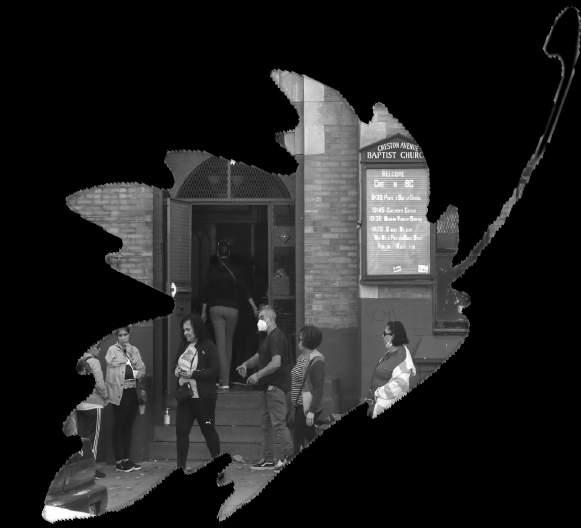


The drive operates in tandem with primarily faith-based nonprofits with which Fordham has a sustained partnership. At Fordham College at Lincoln Center (FCLC), Fordham works with the church of St. Paul the Apostle’s Loaves & Fishes Food Pantry and Xavier Mission. At Fordham College at Rose Hill, the drive is partnered with the Church of our Lady of Mercy, Part of the Solution, and Creston Avenue Baptists Soup Kitchen. The Westchester campus collaborates with the Carver Center.
Although there have been multiple campus food drives by various departments and organizations over the years, the Director of Campus Ministry Operations, Budget, and Community Engagement Gil Severiano said that Campus Ministry’s has been going on for at least 10 years.
The food drive accepts monetary donations to help the nonprofits operate more effectively.
“They’re able to cook a meal in bulk for hundreds of people — having the money to buy the items at a reduced rate in bulk goes a lot further than mismatched canned food items might go,” Erin Hoffman, director of Campus Ministry at FCLC, said.

This also allows organizations to purchase fresh turkeys and produce rather than processed
“Many populations struggle with food related high



blood pressure or obesity so we provide monetary donations for community partners to distribute fresh healthy foods,” Severiano wrote.
Hoffman also said that it is important to remember those in need throughout the entire year.
“These needs don’t just come and go in November and December. But it is a time when people are more open to giving,” Hoffman said.
In terms of how the organizations use the money, Campus Ministry does not stipulate which initiative the money must be used for, or when.
“We tell them the donation was made from our food drive for their Thanksgiving distributions (but they decide how they will use the money). They know the members of their communities, and what is culturally appropriate food to provide for them,” Severiano wrote in an email.
Severiano said that while donations have remained steady, the cost of living increases every year.
Gabriella Sacci Adickes, president of the St. Vincent de Paul Conference at St. Paul’s, said her church accounts for this fact.
“With the costs rising and the people who need help rising, we’re very very grateful. You have no idea, because we never want to turn away anyone for lack of having anything to give them,” Adickes said.
Adickes said that before the pandemic St. Paul’s served roughly 85 families a month. Now, they serve around 250 families a month on average.
The majority of their visitors receive public assistance, so the pantry takes place on Saturday
in the third week to relieve costs in-between assistance comes
“It’s an outreach borhood to bridge between what able to afford, and to provide for their lot of people are making ends meet, honest, working said.
St. Paul’s works Bank of New York balanced bags Adickes said St. a recent diminishment grant money, so Fordham are all ant.
“We want to greater than we We’ve been called food pantry in New think there’s a lot destigmatize the Adickes said.
One of the greatest ries of the food pantry opinion was a rian immigrants. living in a shelter and began to regularly food pantry after line. St. Paul’s was the family with ing and specialized an ill family member.
Adickes said the family is now and the son of the cessfully pursuing
“We’ve mentored last five years of scholarship at one Catholic schools he’s thriving, and own apartment,” Adickes encourages get involved with


week of each month in-between when in. outreach to the neighbridge the gap our visitors are and what they need their families … A having difficulty meet, and these are people,” Adickes works with the Food York City to create of groceries.
Paul’s did have diminishment in their so partners like the more importto leave people found them … called the friendliest New York City. I lot to be done to whole process,”
greatest success stopantry in Adickes’s family of NigeThe family was shelter pre-pandemic regularly attend the after they saw the was able to provide groceries, clothspecialized food items for member. with pride that now on their feet the family is sucpursuing his education. mentored him for the of his life into a one of the best boys in the city, and and they’re in their Adickes said. encourages anyone to with volunteering.
“It feels so good to do something. You could look at it as being like a drop in a bucket, but it’s something,” Adickes said.
Xavier Mission started 41 years ago as a grassroots organization from the parish themselves and has since grown into multiple programs. They offer a customer-choice food pantry in a shopping-style environment, as well as a clothing room providing casual clothing, business attire for interviews and toiletries. They have served over 1,800 guests and distributed 60,000 pounds of clothing.
The mission also offers financial assistance to families under threats of eviction, and the LifeSkills Training and Empowerment Program. This is an educational program in operation since 1995 that provides mentoring, trauma-informed group support, life-skills training and support to homeless individuals and veterans.
Paige Finley, FCLC ’25, has been an active supporter and volunteer for Xavier Mission throughout her time at Fordham. She was introduced to them in the first semester of her first year while on a trip with a Fordham group.
“I just decided to go back on my own because I had such a great experience, and I’ve been going ever since,” Finley said.
She spends most of her time with Xavier Mission volunteering at their Welcome Table soup kitchen, which is open from 1-3 p.m. on Sunday afternoons and Thanksgiving day. They usually serve anywhere from 900 to 1,500 meals every Sunday.
“It’s a real restaurant expe rience. The guests come and sit

down, they’re allowed seconds and can stay as long as they want to stay,” Finley said.
Rob Parmach, director of the Ignatian Mission and professor of philosophy at FCLC, teaches a community engaged learning philosophy and ethics course. The course has two community partners, one of which is Xavier Mission.
“Last Sunday, I took all 35 students and I went to work at their Welcome Table and we served food for 1,000 people,” Parmach said.
Parmach said that connecting with people goes beyond distributing meals.
“It’s nice where somebody gives you food, but it’s more important where you use the food as a vehicle to connect to their humanity,” Parmach said.
Campus Ministry also collaborates with Fordham’s dining services to conduct the Swipe out Hunger program, which allows students with meal plans to donate food swipes to students experiencing food insecurity.
“This way lost meals don’t go to waste, and you’d be surprised sometimes that someone just needs a few meals to get them across the finish line,” Parmach said.
For the food drive, with rising costs of living and numbers of people in need, Severiano said that donations are more important than ever.
“We are grateful, as are our community partners, for every single donation. Many small gifts make a huge impact!” Severiano





As a transgender woman, it is hard to go anywhere without being gawked at, fondled or even brutally harassed. Interestingly enough, these actions usually come from members of the far-right. Many Republican men have groped me at bars and clubs in New York City, displaying their strange, seemingly paradoxical affinity for trans women.
Nonetheless, I have had encounters with many Republicans by accident. I have spent significant amounts of time with men that I think I like — only to find out later that they are Republicans. While I do not believe in their politics, elephants can be better than donkeys in the sack. As an opinion columnist and transgender woman, I can confidently state that I do not support Donald Trump. I do not like the Republican Party, and although I voted for Kamala Harris, I am not down on my knees for the Democratic Party either. Although my perspective might skew far left on this issue, I still believe that conservatism is a coping mechanism for closeted bisexuality.
This is specifically about the sexually repressed, macho, Christian, heterosexual guy who cannot accept himself and takes it out on everyone else. Perhaps this is not always the case. Hate is taught. Some people genuinely believe the white supremacist, transphobic, misogynistic rhetoric that Trump has ignited in his base. However, I would like to analyze the closeted bisexual Republicans I have come across to see if there is a common denominator.
My first relationship with a Republican was in my senior year of high school. He was the captain of two varsity sports teams at the rival school, and I was a twink. He now works for a prominent conservative news operation. We were star-crossed lovers. Recently, he tried to come back into my life, calling me multiple times late at night.
I wanted to know what was happening, and wanted inspiration for this column. Turns out he’s still struggling with his sexuality, and he wanted to talk to someone about it. He said, “I think I’m possibly into everything.” I told him, “You’ve thought you’ve been into everything for the last four years. Maybe it’s time to just be into everything.”
My only other long-term encounter with a Republican was also from my hometown. I grew up in a very conservative neighborhood. He was my bully in elementary school. We were friends, until he started calling me slurs. At lunch, he would take off his shoe and beat me with it. At a birthday party, he punched me across the face and gave me a bloody nose.
By the time senior year rolled around, we had forgotten about our childhood beef and decided to rekindle our friendship. It evolved into something more, but definitely nothing romantic. I knew this guy was not politically oriented toward his best interests as a queer person. It was clear to me that he had some deep-seated repression and desire. I needed to emerge victorious in the end. I needed to conquer the person who hated me. Let’s just say that story came full circle.
My other encounters with Republican men have been brief and few and far between. While I have an obsession with understanding the people who hate me, I do not want to have sex with them. Despite the inherent eroticism to guilt, I do not find joy in changing the minds of the people who hate me
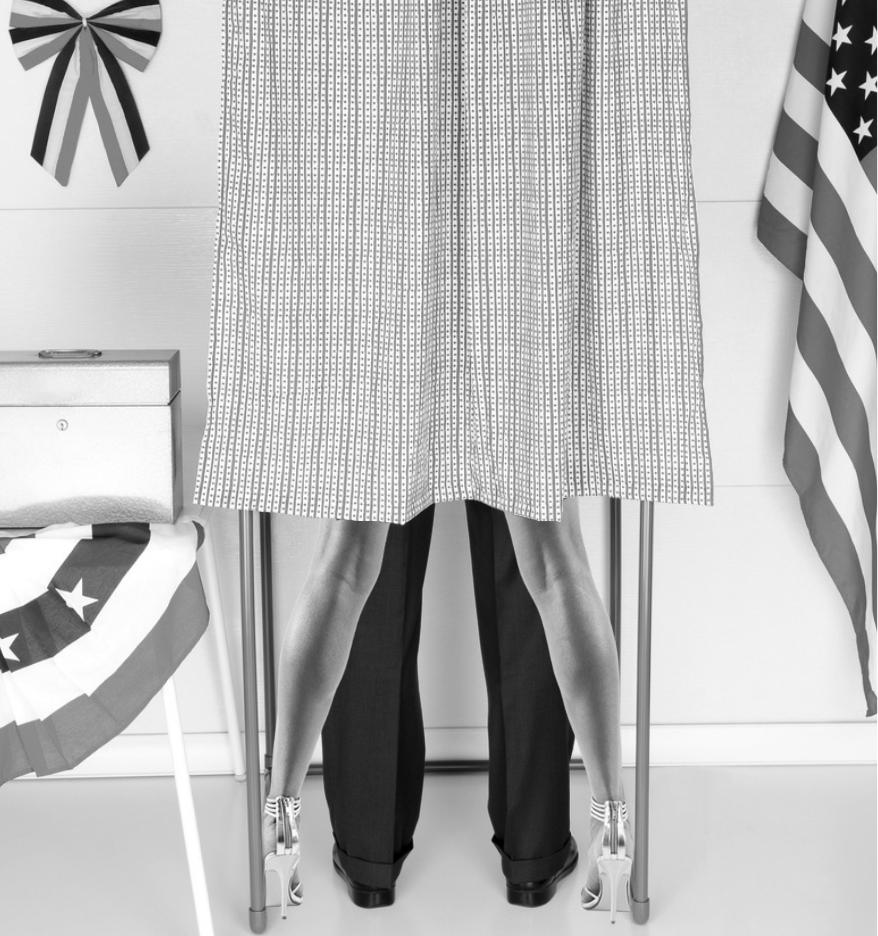
through sex. It does not work. I learned that the hard way.
Guilt can be at the root of that deepseated desire. In the past, I was guilty of having sex with someone that hated me for my identity. Americans live in a guilt culture, constructed due in part to our Christian bedrock. Guilt informs how authority figures derive power and monetary advantages. If one can be guilty of less, one can remain in power. Christianity and Catholicism especially function on the principles of confession. Guilt culture is derived from these principles and informs American society.
The threat queer people pose to the “sanctity of marriage” and the “protection of the nuclear family” is based on the notion that these institutions are more virtuous than queer lives. Conservatives construct an inherently “guilty queer” in their rhetoric, and I wonder if they might be telling on themselves. Are Conservatives guilty of being queer? Is their whole belief system an attempt to cling to power while coping with being in the closet?
Back in May, Trump shared his concepts of a plan to block doctors who provide gender-affirming care from Medicare and Medicaid, forbid federal agencies from promoting “the concept of sex and gender transition at any age,” and investigate the medical industry to see if they “deliberately covered up horrific long-term side effects of sex transitions in order to get rich.”
Recently, I attended a Trump demonstration outside of the vice presidential debate as an unbiased student journalist. While partaking in unbiased student journalism, I did, in fact, notice some hotties. Yes, if I am being as unbiased in my reporting as possible, some Trump supporters are physically attractive. They were all dressed up to watch their idol, J.D. Vance, spew non sequiturs and fake news on national television. Something about their complete ignorance is special, like doting sheep on a prairie.
One of the Trump supporters came up to me and asked my pronouns. I responded, “Um. Well. As an unbiased student journalist, I cannot answer that question. I guess.” He was gangly and awkward, slyly analyzing my body, looking me up and down while I stuttered. He assured me he was not trying to be funny or make me uncomfortable. He was just trying to make conversation. He apologized if it came off as awkward or unnecessary. At the very
least, he was displaying allyship?
While I did not think he was attractive, I think that he shows hope for our young Conservatives. Maybe they will come to terms with the fact that there is a queer bone in their body. People often say that, “everyone’s a little bit gay,” but for the longest time, I did not think that was true.
Scientists at Cornell and sociologists at the University of Winchester and the Queensland Institute of Technology, have teased out hypotheses and conducted studies on the theory of universal bisexuality. Bisexuals make up the majority of queer adults at 57.3%. As a bisexual, transgender woman, I believe that everyone is bisexual. Queerness is desirable because it is shameful and therefore something you should feel guilty about. Guilt is a turn on.
Perhaps this is why Republicans are fascinated by trans women. In 2016 while bathroom bans were happening in North Carolina, transgender pornography was trending in that same state, reaching 64.3% on popular adult entertainment sites. In 2022, transgender porn was the third most popular category on Pornhub. In 2023, “femboy” and “trans” were among the top 30 search terms on Pornhub, and “transgender” was the sixth most popular category.
In spite of this, in 2022 and 2023 alone 778 anti-trans bills have been considered in the United States. 113 anti-trans bills were passed in those years. In 2024 alone, 662 anti-trans bills have been considered while 45 have been passed. Do Republicans feel guilty about the legislative attack on transgender people? Is that why they are watching so much transgender pornography?
Republicans believe that our transness makes us morally inferior. In their view, transgender people should learn to live as their assigned gender at birth or die trying. We should feel indefinite guilt about our trans identity, and they should feel endless guilt about finding us attractive.
If you are bisexual, be bisexual, be queer, or whatever you want to be — no one cares. It is okay to like boys and girls, someone, something and something else. You can like boys differently than how you like girls. You can like one thing differently than how you like another. You still like both things or all of the things or a specific few things. I think it’s time Conservatives came out of the closet.

As students here at Fordham Lincoln Center, many of us can acknowledge the importance of Quinn Library and the need for a shared space to study, relax and collaborate. We recognize the value of this space as it can offer not only education, but also refuge. However, as important as Quinn Library is to our community, it is even more essential to extend this same appreciation to public libraries.
There are 92 New York Public Library (NYPL) branches throughout the Bronx, Manhattan and Staten Island, all of which work toward sustaining our communities through various forms of support. However, libraries’ capacity to provide this support was threatened last November when Mayor Eric Adams announced a $58.3 million budget cut that would prompt the reduction of library hours, the elimination of Sunday service and the restriction of several social programs. Thankfully, these funds have since been fully restored because of the efforts of local organizations and community members alike. In the four months following the release of said budget cuts, NYPL patronage drastically increased.
According to a report on service throughout the city, visitorship rose from 2.4 million to 2.6 million, and library card registration increased by nearly 53,000 compared to the previous fourmonth period. These significant boosts exhibit the heightened demand for library services and


highlight the growing importance of participation in local libraries. Unfortunately, the pressure of local organizations alone is not nearly enough to keep libraries afloat, and every single library visit was instrumental in resolving this issue. Each individual act of participation adds up, reminding our local government of the essential functions of these public centers.
Although funding was eventually restored to its original numbers, budget cuts may still occur. According to a June 2024 article by CNN, a flat budget in an inflated economy will be greatly detrimental to the NYPL.
According to the NYPL President Tony Marx, “library operation costs are increasing across the board for wages, health insurance, library materials, maintaining collections and technology.”
Therefore, it is vital, now
more than ever, to contribute to your local library by borrowing books, registering for a library card and engaging in programs and services. While public libraries may be a second choice for some, they are essential to others. By supporting them, you keep them relevant and funded, one book at a time.
An essential service that libraries provide is free internet access. Post-pandemic, researchers at Arizona State University’s Center on Reinventing Public Education, found that the digital class divide had become increasingly visible. As schools and workplaces continue to digitize, access to technology is becoming increasingly necessary. Libraries are one of the few places where those without access to computers, printers and high-speed internet can use these resources. Libraries also provide youth services, such as homework
assistance, tutoring, resume workshops and even college and job preparation seminars, all of which contribute to a child’s success within and beyond the classroom.
Public libraries also provide a sanctuary for those who are unhoused, offering entertainment, public restrooms, refuge from the weather, and, in some cases, social workers who can connect them to community aid.
Available via the NYPL website and library advertisements, the NYPL libraries also offer numerous resources for immigrants and refugees, a service that is becoming increasingly important as asylum seekers move to the city. These services include multilingual resources, free English classes, ActionNYC legal help and preparation for citizenship interviews and exams. On top of this, libraries also support those formerly and currently
Libraries are in danger and we should be supporting them now more than ever Going
incarcerated. The many branches even go as far as to provide free assistance in filing your tax returns.
Variety and versatility are what make libraries integral to our communities; to be able to find so many services in one physical space is extremely rare. Libraries are also now completely free. With the elimination of late fees, it is now even easier to support libraries, and with 219 branches throughout the five boroughs, you’re never too far from one.
Despite all these benefits, how many people our age are really using the library? According to the American Library Association, in 2022, 54% of Gen Z and Millenials visited a library at least once throughout the course of the year. Although this is slightly higher than the majority, it could be vastly improved upon.
While I often go to the library in search of new reading material, I’ve also found that they make for a great day trip, and branches like the Jefferson Market Library and the Stephen A. Schwarzman Building are undoubtedly worth a visit. The NYPL also offers culture passes, a perk that provides free admission for over 100 cultural institutions, like the American Museum of Natural History, the Brooklyn Botanic Garden, the Museum of Modern Art and more.
By engaging with your local library, you are actively supporting an organization that provides education, respite, and community to millions throughout the city. Not only do you gain from participating, but you also ensure that libraries can continue their essential work.
As Fordham students, one of the greatest luxuries we have in New York City is not worrying about finding restrooms. Once we step off campus, however, the chances of accessing a restroom while walking around the city are low, and clean public restrooms are few and far between.
The lack of accessible public restrooms has led to forums and websites that reveal tips and hacks for locating public restrooms throughout New York City, but this should not be necessary.
According to a city council report, there are more than 1,400 public restrooms throughout New York City. While that may sound like a large number, it is minuscule compared to the eight million residents, a figure that excludes tourists. People in New York face Bryant Park’s never-ending line to the restroom, establishments with “no public restroom” signs on their front doors, or, my personal favorite, stores that require you to pay a

fee or buy one of their goods to use their restroom.
The lack of accessible public restrooms has led to forums and websites that reveal tips and hacks for locating public restrooms throughout New York City, but this should not be necessary.
While it is frustrating to be met with a code lock on a door, it is only mandatory for a company to give access to their restroom if someone has a medical condition. According to NYC311, a food establishment that “has 20 or more seats and opened after 1977 … must provide a toilet for its customers.” However, they are “not required to allow public
access to their employee toilets.”
Unsurprisingly, restaurants in New York City have taken advantage of this policy, with most only allowing paying customers to use their restrooms.
While some New York City parks have restrooms that are somewhat accessible to the public, they are far from ideal.
This past September, the New York City Council’s investigation revealed that two-thirds of the 102 public restrooms within the parks were in poor condition. The park restrooms were deemed health hazards, as 40% of the restrooms had prevalent litter and 23% had unsanitary conditions, including “bodily fluids
on surfaces.” Other health issues included a lack of toilet paper, garbage cans and disposable bins for menstrual products.
Given the poor sanitary conditions of public restrooms in the parks and the inaccessibility of restaurant restrooms, it is no surprise that New York City is ranked 93rd out of 100 American cities for accessible bathrooms, according to the Manhattan Borough President’s website on public bathroom access initiatives.
Local officials and advocates are pushing for cleaner, more accessible public restrooms by arguing that bathroom usage is a basic human right. People in
New York City spend a lot of time outdoors, and considering that according to the advocacy organization, the Coalition for Homelessness an estimated 350,000 people in New York City do not have homes, bathrooms do not adequately meet the population’s needs. Everyone’s situation is different, and we cannot assume that everyone in the city can rely on a private institution to provide a bathroom for them.
Local officials and advocates are pushing for cleaner, more accessible public restrooms by arguing that bathroom usage is a basic human right.
In June, New York City Mayor Eric Adams announced that the New York City’s Department of Parks and Recreation will create 46 new restrooms while refurbishing 36 pre-existing restrooms across all five boroughs. While his status as mayor remains unclear after his indictment in September, we can only hope to see an improvement in access to public restrooms throughout the city. In such a populated city, residents search far and wide to use a restroom, an act that should be considered a fundamental human right.

AVERY GRAFELD Opinions Editor
Social media apps were once centered around strengthening personal connections, but since the rise of the addictive For You Page (FYP) on TikTok, short-form content has overshadowed these connections. Designed to keep us scrolling for hours, the FYP isolates us from community-based interactions. Instead of growing as intellectuals, we delve deeper into our own personalized echo chambers. Social media has taken a turn for the worse, and we need a revival of 2016 app culture.
Today, many young people have a main profile and a private one, the latter often reserved for close friends called a “finsta.” But when I was in middle school in 2016, my main Instagram operated as a private account. I had maybe 200 followers — all close friends and classmates from my middle school, and every post was saturated with the gingham filter to maintain an “aesthetic” on my profile. I put so much effort into writing quirky captions only to sign off with popular hashtags like #summer or #photography. It was tacky, but it also felt more authentic than the influencers on my feed today.
Originality is being traded for familiarity. Instead of taking bold leaps, social media platforms are choosing to replicate one another.
I felt like I was in a social bubble. Even though I had access to millions of accounts, my Instagram was relatively dull. I followed a few famous people like Selena Gomez, King Bach and, unfortunately, Brent Rivera. But my real interactions were with people I already knew.
Anonymous gossip and “ship” accounts thrived during this era. With maybe 100 followers, these student-led accounts

posted about the people at my school. Was it ethical? Probably not. Fun? Extremely. My friends and I would submit fake rumors about each other, and it felt like a collaborative inside joke between my class. We were all suspended within a social bubble, exploring the social media wasteland together. I cannot imagine traversing TikTok and Instagram for the first time as a 13-year-old today.
Before TikTok, platforms like Facebook and Instagram relied on what is called a “social graph.”
Behind the scenes, engineers were developing ways to connect users within a network of people that they might have been related to, using this insight to target advertisements, according to Entrepreneur. There was no FYP; instead, your explore page was similar to those of your friends and family. It often distributed content outside your interests, but as a result, your interests evolved.
Fast-forward to the rise of
modern-day TikTok, where we are at the mercy of strangers posting redundant, “brain-rot” content. Community has been replaced by the influencer — wealthy, insufferable and making exaggerated hand gestures when they speak. I rarely interact with my friends’ posts; instead, my feed is flooded with strangers. The relationship I have with these influencers is completely one-sided and parasocial.
According to the Entrepreneur, TikTok was one of the first apps to implement an interest model. It works by capturing your likes and dislikes and associating you with other user groups who share those interests.
The app uses artificial intelligence to rapidly evolve the FYP to reflect your interests. “Passive scrolling” does not exist. Every second you spend watching a video, scrolling through comments, or following another creator is recorded and tracked. You are at the mercy of highly sophisticated software.
It did not take long for other social media platforms to replicate this model. Instagram developed “Reels,” YouTube came out with “YouTube Shorts” and Snapchat procured “Snapchat Spotlight.” Community-based social interactions were discarded in favor of the interest graph. Think about it: when was the last time you scrolled through your feed and liked a post from a mutual you followed? I’m not saying these interactions are rare, but compared to 2016, there has been a steep decline. Originality is being traded for familiarity. Instead of taking bold leaps, social media platforms are choosing to replicate one another. However, this phenomenon is not just restricted to social media. Go to the movie theaters; reboots and remakes seem to be a popular route corporations feel comfortable funding. Why take a risk on a new idea when the sequel is guaranteed to supply profit?
As a result, the interfaces of

Facebook, Instagram and TikTok are all virtually identical. Scrolling through each, you can easily forget which app you were originally on. A shift toward shortform content can be seen across platforms as our attention spans plummet.
Apps replicating one another are nothing new. Nearly 10 years ago, Carol Vernallis released her book Unruly Media, analyzing the complex relationships between social media, films, art, video games, etc. Her work was published in 2013, and she saw similarities between MTV music videos and films; she writes that, “Today each genre’s influences ripple out maddeningly, creating interference, blendings, loosenings of boundaries in ways we’ve never seen.”
Facebook no longer offers one service. According to Investopedia, Meta has expanded its ownership to Instagram, Threads and WhatsApp, each platform morphing into the same TikTok adjacent clone. Who knows? Maybe someday there will be one app to “rule them all,” providing every service imaginable. It’s not far off from where we are today.
In 2016, apps provided one function. I yearn for that return. During my first year at Fordham, there was an attempt to forge an online community between Rams. The account @fordhamflirts would post anonymous submissions from students about their class crushes. Names were not allowed, only descriptors, but many of the comments would be Fordham students trying to guess the described person. I felt like I was back in my middle school’s social bubble.
To those with spare time: please start a Fordham-related account. Make reviews, give advice, start a club and advertise online. Converting your everyday interests into an online platform will create a more authentic experience for you and your friends.
The solution is a return to 2016. Follow your friends and people at Fordham and connect with them. I encourage you to distance yourself from the addictive FYP and influencers you will likely never meet. There is a potential to foster real-life friendships by reaching out to Fordham students on social media.
6,
The Emmy-nominated producer visited Fordham Lincoln Center to discuss her career and faith

By MICHELLE WILSON Asst. News Editor
Fordham’s Center on Religion and Culture (CRC) hosted a panel discussion featuring Emmy-nominated screenwriter and playwright Dorothy Fortenberry on Oct. 29. Moderated by CRC Director David Gibson, Fortenberry discussed her screenwriting process, and how her Catholic faith and passion for combating climate change impact her work.
Fortenberry is most wellknown for her work as a screenwriter and producer on Hulu’s “The Handmaid’s Tale” and Apple TV’s “Extrapolations.”
To open the panel, Fortenberry shared her rather unusual start to screenwriting, beginning in theater writing plays as a young adult. She said there was a time she saw one of her plays performed that was a true “a-ha” moment.
“ In a writer’s room, it’s always hardest if you are the only one of any kind of identity because then you get put on to represent that identity in a way that is impossible.”
Fortenberry,
“This is how I’m supposed to fit into this process. This is where I feel right … It was a very moving feeling,” Fortenberry said. Later in life, Fortenberry moved to Los Angeles, CA and switched from theater to television for both pragmatic and personal reasons. She got involved in screenwriting through the now-defunct free, year-long Warner Bros. Television
Workshop, which offered a bootcamp on how to write for television. Applications were open to anyone who submitted a script for a fake episode of a TV show that was currently airing. After the year was up, any Warner Bros. produced show was incentivized to hire participants as free hires for a 13-week audition period.
This was how Fortenberry was recruited to work on the mid2010‘ post-apocalyptic show “The 100.” The basic premise is that after a nuclear apocalypse wipes out almost all human life, the last remaining survivors are living on a spaceship. The ship’s life support begins to fail, and they send down 100 juvenile delinquents to Earth to see if the planet is habitable.
“There are exactly 100 kids in baby jail on the spaceship, and they’re all very attractive, so they send down just the most hot criminals,” Fortenberry said with a laugh.
She then highlighted a brief clip from the show to illustrate the drastically different demands between writing for theatre and television. Fortenberry said that perhaps the most challenging aspect of that transition for her was the fast-paced nature of TV. She had to boil down the relationship between the two characters and one character’s entire backstory and childhood in a page and a half.
“I was coming from having 90 minutes with my audience, and with ‘The 100,’ it’s six acts and a teaser, so every five pages you’re cutting to commercial … They’re (the audience) about to go watch a bunch of Clearasil ads. If you haven’t made it exciting enough, they will not come back,” Fortenberry said.
Fortenberry left “The 100” halfway through season three after the birth of her second child. At that point, the Writer’s Guild had no parental leave (which was amended in the 2017 contract), but she soon received a phone call from television writer Bruce
Miller to work on “The Handmaid’s Tale.”
In a somewhat recurring theme of Fortenberry’s career, “The Handmaid’s Tale” is another post-apocalyptic show. She faced unique challenges in adapting the 1985 novel to the screen: the protagonist in the book has rather limited knowledge of the world around her.
“If you’re making a TV show, you actually can’t be in perspective. You have to show the whole world, so we end up showing a lot more of the world than the book did,” Fortenberry said.
She said her passion for these issues are heavily influenced by Pope Francis’s statements in his encyclical, “Laudato Si.”
She described the writer’s room for “The Handmaid’s Tale” as an incredibly diverse environment representing women from all religious (and non-religious) backgrounds to answer questions like, “What does it mean to have a female body, and why might somebody believe in God? What does it mean to have a female body and be part of a patriarchal religious institution?”
In the context of her Catholic faith, Fortenberry described Hollywood as having a real value of tolerance for people of all faiths. However, she acknowledged the difficulties that can arise when one has to represent a particular identity as a monolith.
“In a writer’s room, it’s always hardest if you are the only one of any kind of identity because then you get put on to represent that identity in a way that is impossible,” Fortenberry said.
After working on four seasons
of “The Handmaid’s Tale,” Fortenberry transitioned to the Apple TV+ show “Extrapolations.” Set after a climate change disaster, each episode of the anthology series is set in a different year and country, and a cast packed with stars like Daveed Diggs and Meryl Streep. She described it as “‘Black Mirror’ for climate change.”
“‘The very hot and the very famous are the ones who survive’ is what you’re learning today,” Fortenberry joked.
Fortenberry got the job quite unconventionally. She had long been frustrated with the lack of representation of climate change in film and television. She said her passion for these issues are heavily influenced by Pope Francis’ statements in his encyclical “Laudato Si.”
“Christmas episodes and holiday movies all have snow even when it doesn’t snow in those places anymore. Our television climate sticks to a non-climatechanged world, and it’s just out of step with our reality,” said Fortenberry.
Fortenberry recalled how she often expressed these frustrations online, which unexpectedly prompted invitations to panels about climate change. In 2020, Fortenberry spoke at a panel on climate in storytelling organized by the Natural Resources Defense Council with Scott Burns, the showrunner for “Extrapolations.” Immediately after, he asked her to be his co-showrunner and executive producer, and she jumped at the opportunity.
“Extrapolations” was unique in that it did not have a traditional writer’s room. Writers were not coming together to figure out the beats, main events, in an episode. Instead, each episode had a different writer who wrote the script based on paragraph summaries. This allowed the show to explore the topic from many different perspectives.
Being an executive producer instead of a writer was a new role for Fortenberry. She described the
process of doing a global search for an actor who was both South Asian and had a disability for one of the characters. Not only did she have to cast him, but she also had the responsibility of sorting out his visa application process. This position presented new challenges for Fortenberry, but, while she missed writing, she stated that being an executive producer
“ For me, climate despair comes from inaction ... I am less filled with despair than when I am inactive.”
was still very enjoyable for her. She explained that she admires “Laudato Si” because it has a “deep love” for humanity while still discussing and criticizing issues of climate change. “I did not want to make a show where people were the problem,” she said.
Fortenberry reflected on staying positive while working with heavy subjects like climate change on “Extrapolations.”
“For me, climate despair comes from inaction. As long as I feel like I’m doing something, whatever that is, whether that’s working on this giant fancy show or tweeting into the wilderness, I am less filled with despair than when I am inactive,” Fortenberry said.
Fortenberry’s rapid switches between humor and insightful commentary on her writing charmed the panel’s attendants. Her strong values and passion for change shine through in all of the work she discussed.
Fortenberry’s journey illustrates her storytelling ability and underlines the intersections between art, faith and social responsibility.
‘Romeo
Broadway’s latest revival of ‘Romeo + Juliet’ reminds us that the classic romance is more than just a love story
By JULIA JARAMILLO
Arts & Culture Editor
Years after I first read “Romeo and Juliet” in high school, I never thought pastel teddy bears and synth music by Jack Antonoff would help me further understand the line “for never was a story of more woe, than this of Juliet and her Romeo.”
On Oct. 24, director Sam Gold’s revival of “Romeo + Juliet” opened on Broadway, starring young acting sensations Kit Connor and Rachel Zegler in their Broadway debuts.
The tale of Shakespeare’s “Romeo and Juliet” is the classic star-crossed lovers story. The dangerous feud between the Montagues and Capulets has been recreated and reimagined countless times. According to the New York Theatre Guide, Gold’s production is the play’s 37th revival on Broadway.
The aesthetics of this modern version are stark, bold and bright. Across promotional material, Connor, Zegler (playing Romeo and Juliet, respectively) and the rest of the cast were captured in color-filtered, somewhat grainy photos paired with simple, saturated text. It made the production feel more like a 21st century coming-of-age indie film rather than a 16th century Shakespearean play. The tagline “The Youth Are F**ked” is displayed across the website, social media and other promotional material.
Descending into the Circle in the Square Theatre, a saturated red glow illuminates the audience. There’s a muted bass booming in the background as cast members quietly enter the stage one by one. They mess around
with the random props on stage: a shopping cart filled with stuffed toys, an inflatable lounge chair and a pack of water bottles.
The play commences with a rager-esque dance party introducing the cast and their roles. A DJ stands in the back playing the synthy, electropop tracks of Antonoff. It’s quite easy to forget that this is supposed to be Verona, Italy.
That feeling is most noticeable in the costumes, designed by Enver Chakatash. The entire cast wears trendy, bright streetwear. Mercutio (Gabby Beans), Romeo’s close friend, sports baggy jeans and a tank top. Juliet’s arranged fiance, Paris (Gían Pérez), wears a T-shirt that says “Gift of God.” Juliet often wears Doc Martens and dons a strappy, glittery dress to the Capulet’s party in Act 1.
Little to no changes were made to the original script itself. Gold did not incorporate smartphones or a random social media scene, making the time and setting somewhat blurred. This version of “Romeo + Juliet” is ragingly Gen Z. The cast spoke and acted Shakespeare with the mannerisms of a young modern adult. It amusingly changed the delivery of lines like “Come, we burn daylight, ho!”
Despite the modernization, the production was able to maintain the poetic, tragic sorrow of the original love story while shining light on its often overlooked role as a cautionary tale about hate and negligence. Romeo and Juliet meet a tragic end in the original play because their parents were too busy feuding and kept deciding for their own children.
Gold’s production is partly a testament to the timelessness

of Shakespeare’s “Romeo and Juliet,” but his vision for this production made it all the more prominent and framed it in a way appealing to a younger and wider audience.
Notably, “Romeo and Juliet” has over 20 speaking roles, but this version consists of only 10 cast members. Many of the roles are played by the same actor. For instance, Beans also plays the neutral Friar Laurence, who acts as an emcee. Tybalt and Juliet’s nurse are played by Tommy Dorfman. Lady and Lord Capulet pretty much become the same character, with Sola Fadiran portraying both. They all play their roles brilliantly, but there are little visual and acting distinctions between characters, blurring the line of who’s who. At one point, Beans explicitly declares that she’s the Friar now as she steps on stage. These maneuvers were
somewhat confusing, but this casting places more attention and emphasis on the two lovers themselves and their tragedy. Romeo and Juliet were two teenagers left on their own. While the tale largely follows their romance, their love story also serves as a warning to what can happen when the youth are neglected in a violent world. Tragedy and misery unfold.
Connor’s performance as Romeo was phenomenal. Perhaps it is because I have already seen him as a young golden retriever boyfriend in “Heartstopper,” in “Romeo + Juliet,” he embodies a young, sincere, wide-eyed lover boy again. During the iconic balcony scene, he eagerly runs up and down and around the theater, passionately soliloquizing his love for Juliet. The viral pull-up he does on her suspended bed to kiss her cements his commitment to Juliet and his character.
The only part that brought me out of the dreamy, poetic mood were the production’s two original pop songs, both sung by Juliet. The first one was arguably fitting, taking place at the Capulet’s party when Romeo first meets Juliet. The second one takes place right after Romeo is exiled for killing Tybalt. As Romeo is lamenting his banishment, Juliet comes out on stage and sings a slow pop ballad about her admiration and love for him. While Zegler is an amazing singer and played Juliet wonderfully, it felt like this track was forced in.
Gold’s “Romeo + Juliet” is a fresh take on a centuries-old tale, serving as an introduction to Shakespeare for some audiences by providing a new breath to a classic.
“Romeo + Juliet” will have a 20-week run on Broadway, with its final performance taking place on Feb. 16, 2025.
The LA rapper reflects on his struggles with identity in his newest album
become.
By KATIE HOHMAN
Asst. Arts & Culture Editor
Tyler, the Creator — the stage name for 33-year-old Los Angeles native Tyler Okonma — released his eighth album titled “Chromakopia,” on Oct. 28. This newest project, which combines hip hop, jazz and R&B elements throughout its 14 tracks, is an intimate and personal look into Tyler’s battle to unmask his true self amidst the struggles of fame.
The release of “Chromakopia” marks a departure from Tyler, the Creator’s previous project “Call Me If You Get Lost,” a heavily stylized release that featured grandiose songs about traveling the world and enjoying fame. The album, which was released in 2021 and subsequently re-released as a deluxe version titled “The Estate Sale” a year later, won the Grammy Award for Best Rap Album in 2022.
In comparison, Tyler’s newest work is a more introspective look into his upbringing and experiences growing up in Hawthorne, Inglewood, CA. The album is narrated by Tyler’s mother Bonita Smith, and her voice is threaded throughout the tracks as she addresses both her son and the listener.
Notably, this newest album is devoid of any dramatic persona, which is a tradition that has become synonymous with the rapper’s style, especially after the release of “Igor” (2019) and “Call Me If You Get Lost” (2021). Instead, listeners are given a deeper, more honest look into who Tyler (the man, not the character) is and who he is learning to
“Chromakopia” partially revolves around the idea of wearing a mask, both literally and figuratively. The album’s cover art features Tyler himself in a lifelike mask, and the song “Take Your Mask Off” tells the story of three fictional characters who all hide their true selves.
From a preacher who is forced to hide his queer identity (“Had you thinkin’ God would hate you so you covered it up/Gotta hide how you live, what you really enjoy”) to a stay-at-home mom who wants more from life (“You want your life back and a massage/Tired of bein’ at home, personality gone”), Tyler exposes the masks that people wear to survive.
And ultimately Tyler’s own struggles with identity take the stage on “Chromakopia.”
In the emotional song “Like Him,” Tyler reflects on his relationship with his absent father, and the futility of wanting to know more about someone who is not present in your life. With lyrics like “Mama, I’m chasin’ a ghost/I don’t know who he is,” Tyler seems to recognize how useless his desire to get to know his father really is.
Despite this, he asks the audience (and his mother) “Do I look like him?” — a lyric that repeats throughout the song. As Tyler concludes the final verse with the harsh, but perhaps true, lyric “I don’t look like him,” he seems to finally reject his paternal obsession and the man it stems from. From this, Tyler can build his own identity apart from his father.
“Chromakopia” does more

than just act as a reflection of Tyler’s identity struggles. It also addresses how his rise to fame has changed him, with the song “Noid” (short for Paranoid) exploring the harsh realities of stardom.
He expresses his suspicions with the lyrics “living between cameras and recorders/I want peace but can’t afford ya,” which conveys both his desire for quiet and his inability to ever attain that. Instead, he has become paranoid, constantly afraid that “someone’s keeping watch” to the point that he can’t trust his own shadow. This adds to the larger theme of hiding one’s identity, as Tyler must hide himself in order to protect himself from others.
Tyler candidly addresses his fans with the line “No cameras out, please, I wanna eat in peace,” pleading with the listener to not disrespect his personal space. This theme is made clear by the music video for “Noid,” which features Emmy Award-winning actress Ayo Edebiri as an invasive fan. Accompanied by powerful guitar chords and backing vocals from artist Willow, Tyler runs from the camera donning a mask, but is unable to truly escape his paranoia. Another aspect of “Chromakopia” that makes it stand out from Tyler, the Creator’s past projects is the sheer amount of female artists and rappers that are featured throughout the 14 tracks.
on Oct. 28.
While some fans expressed disappointment that fellow Odd Future member and longtime collaborator Frank Ocean was not included, this newest project let female rappers shine.
Two notable highlights are the songs “Sticky” (featuring Sexyy Red and GloRilla alongside Lil Wayne) and “Balloon” (with Doechii), songs that play into being unapologetically true to yourself and taking the mask off despite what it may bring.
Tyler, the Creator will be starting his “Chromakopia” world tour in February 2025, traveling alongside Lil Yachty and Paris Texas. He will be performing two shows at Madison Square Garden on July 14 and July 15.
de los Muertos grants time to reflect on lost loved ones and establish connections across communities
By SOPHIA STEPHAN
Contributing Writer
On Oct. 31 and Nov. 1, students across both Fordham campuses gathered to celebrate Dia de los Muertos. At Fordham Lincoln Center (FLC), events were hosted by Student Organization of Latines (SOL), the Office of Multicultural Affairs (OMA) and Campus Ministry, who collaborated to create an impassioned and unforgettable event following Mexican tradition.
Dia de los Muertos, or the Day of the Dead, is a period where mourning for death is exchanged for celebration of life. While it originated in Mexico, it is honored across Latin America and now brought right to our campus by FLC’s Latine community. The events held included an ofrenda building, the All Saints’ Day Bilingual Mass and the Dia de los Muertos Celebration.
Beyond its literal translation, Dia de Los Muertos holds meaning to each individual, whether that be a prioritization of tradition, family, friends or community building. Alexandra Pupo, Fordham College at Lincoln Center (FCLC) ’26 and public relations representative for SOL, reflected on the significance of the celebration in her culture.
“ Sharing, storytelling, is something that brings people together; food brings people together all the time. ”

“I’m Cuban, and a lot of the values that lie under Dia de Muertos are very similar to my values of keeping those people that have passed very near and dear to our hearts because they’re always looking over us,” Pupo said. “As a Catholic, that’s what we’ve always been taught, and we always stay super close to the past and our ancestors because that roots us in who we are.”
Marie Castro, vice president of FLC’s OMA, said that this particular event is able to cultivate important cultural education and experiential learning.
“Sharing — storytelling — is something that brings people together; food brings people together all the time,” Castro said. “I often feel like most of the people in the room typically don’t celebrate Dia de Muertos and they love to learn and they’re open to learning. I think that’s why we continue to do these events, because people are being so open minded and so appreciative of learning about different cultures, of something different from their own.”
Dia de los Muertos has a range of beautiful traditions to take part in, connecting widespread religious and cultural aspects to more personal values. The cornerstone of this connection, and the most important part of Dia de los Muertos, are the “ofrendas”.
Ofrendas are altars created by families to honor loved ones who have passed. These beautifully colorful and meaningful arrangements are believed to encourage visits from the land of the dead by showing departed souls the path to join the celebrations. SOL members built a vibrant ofrenda altar in St. Rupert Mayer’s chapel on Thursday, setting up pictures of departed loved ones and

making space for other offerings to be made over the two-day celebration.
Erin Hoffman, director of Campus Ministry at Fordham Lincoln Center, shared how moving she has found the ofrendas.
“I’m just always really touched by both the individual stories that are shared in submitting things, but then the collective, seeing all of it together and just recognizing that loss and grief and love, are a part of our human experience collectively,” Hoffman said. “I think there’s a lot of actual hope and camaraderie that comes through in the celebration of recognizing the part of life that grief plays and how we’re not alone in it, and maybe come together as a community.”
The altar will be open to any additional offerings for the entire month of November.
The altar will be open to any additional offerings for the entire month of November; all are welcome to submit or bring pictures of loved ones to the ofrendas in St. Rupert Mayer’s Chapel. The pictures on the altar create a lovely image of inviting the remembered to rest on a bed of “flor de muerto,” or marigolds. In the very same chapel on
Friday, the All Saints Day Mass was held with both Spanish and English readings. The light streamed through the stained glass windows onto the new ofrendas and filled the room with a quiet comfort. Those in attendance seemed connected by the significance of both the Catholic holiday and its connection to Dia de los Muertos; these atmospheric qualities created an emotional space, allowing me to reflect on the people in my life by giving me the time to do so.
Fabiola Santiago Ruiz, FCLC ’25 and president of SOL, said there is significance in committing time to reconnect with departed loved ones.
“To me, Dia de Los Muertos is about keeping those who you love but have lost close to you. I think it’s a beautiful tradition of just feeling their presence with you,” Ruiz said. “I have lost my grandparents … you think of them throughout the year, but this is a really good day to kind of do that mental exercise and feel them close.”
The presence of a loved one can be kept in many ways. Chelsea Veras, FCLC ’26 and vice president of SOL, shared how she and her family are able to feel connected to those who have passed in day to day life.
“We honor the people that have passed in my family by wearing their favorite colors or having it in the house,” Veras said. “My aunt, who passed a couple years ago, her favorite color was green.
And so when me and my family moved, the theme of our house: entirely green … It brings us peace and it makes us feel more connected to my aunt.”
Members of all parts of the Latine and Fordham community joined SOL, OMA and Campus Ministry over tamales and tacos to celebrate with crafts, music and conversation.
Following the All Saints Day Bilingual Mass was the longawaited Dia de los Muertos celebration. Members of all parts of the Latine and Fordham community joined SOL, OMA and Campus Ministry over tamales and tacos to celebrate with crafts, music and conversation.
Brianna Perez, a graduate intern and the overseer of the Latine community for OMA, explained their mindset in hosting the celebration.
Perez said, “We believe that celebrating Dia de los Muertos, or this type of event, can help prioritize student voices from different backgrounds and communities, especially in the process to make sure this event remains authentic to them.”
While the lively tunes and the authentic Mexican candy set a festive tone, Michelle Mansilla, FCLC ’28, and Valerie Ramirez, FCLC ’28, said they felt that the event did not quite stir that inspirational or home-like feeling because of the low number of attendees.
“I think now with the food, it’s definitely a homey feeling,” Mansilla said. “I don’t know, right now I just don’t feel a sense of community just because it’s so scattered.”
“Obviously it’s not my family,” Ramirez said. “But it’s nice to know that a club is able to introduce this holiday to some people that may not know about it, or even students that may be away from home and just create a little place where they could just come and kind of feel connected to what they’re used to.”
This reflection highlighted the need for people and community, especially when celebrating those people or communities we may have lost. Regardless of cultural or ethnic background, we are connected by the human experience of both grief and hope, which are intertwined in our embracement of death and life.
These Dia de los Muertos events hosted by SOL, OMA and Campus Ministry are now a Fordham tradition of two years, and will continue to be significant in celebrating Latine culture.
This article is dedicated to my Bà Ba, who we mourn on Oct. 24, but celebrate each day.







BY DAMIAN GROVE
17. Sounds pronounced with the back of the tongue
18. Air Lines name derived from the Greek alphabet
19. Camaro ___-Z
21. ___ la vie!
22. Advanced degree for a behaviorist (Abbr.)
23. Straying from the proper course or standards
25. Chinese province with
capital Shijiazhuang
27. First-generation JapaneseAmerican
28. Music genre of Mariah Carey and Stevie Wonder (Abbr.)
30. “Wrong!” (2 Wds.)
31. Sunny prefix?
32. Cow meat: b___
34. 2021 Ryan Reynolds film: “Free ___”
35. Relating to birth
37. National protection agency that provides geographic information (Abbr.)
38. Camera setting: ___-mo
39. Deadpan humor
40. Relating to the eye
42. The powdered variety often tops baked goods
44. Strong string
45. Synthetic fabric
47. Congress is part of the legislative ____
49. Income tax amendment
50. Low heeled boots introduced in the ’60s (Hyph.)
52. Chinese dynasty ruled by the Yelü clan of the Khitan people from 916 and 1125
53. Bostick best known for playing Rodrick in “Diary of a Wimpy Kid”
55. What you might need to get to the airport (2 Wds.)
57. Agency which “ensures America remains the undisputed leader in space” (Abbr.)
58. The best of the best
59. “Over my dead body!”
BY JASMINE WHITE
Instructions: Each row, column and 3×3 box must contain the numbers 1-9 exactly once.
60. Measure of a country’s economic activity (Abbr.)
61. Raced down the slopes
62. Lock of hair
1. British patriarch who reigned during WWI (Abbr.)
2. *Not-so-romantic date many went on this week? (2 Wds.)
3. Hyper ending?
4. Embarrass
5. Genus of flowering plants known as the false madworts
6. Immediate
7. *Executive quality?
8. Some can be essential?
9. “Minecraft” explosive
10. Bobby Darin hit “Beyond the ___”
11. Ballet move
12. They dangle from the ears
13. Infamous Disney villain number: “___ Unfortunate ___” (2 Wds.)
20. *Rightfully state your mind? (3 Wds.)
24. “Duck Hunt” and “Dr. Mario” console (Abbr.)
26. *Places to drop your opinion? (2 Wds.)
29. Djo TikTok hit: “End of ___”
31. Eye irritation
33. Trendy currency relying on beauty?
36. Egotistical and conceited

3 6 5 9 3 1

41. Work/time, in physics (Abbr.)
43. Nothing ventured, nothing ___
46. Observant jotter
48. 12-Down variety
49. Seventeen, in Roman times
51. “All You Had To Do Was Stay” lyric: “People like you always want back the love they ___ away”
53. -perate and -truction prefix
54. Forest beast
56. Tax agency (Abbr.)



BY ABBY GRUNZINGER
RAM LIBS GRAPHIC BY CHAISE JONES
Ramses is feeling really _________________ about the election this year, so he made a voting plan with his friends _________________ and _________________. All three of them got up early on Tuesday morning to head to their polling place: _________________. On the way,
though, Ramses got distracted because of some commotion nearby. He _________________ rushed over to see what was going on. As it turns out, there was a _________________ lookalike competition happening just _________________ blocks away! The grand prize was _________________ dollars, so Ramses entered the contest. He didn’t realize there would be a dance-off portion, so he picked _________________ at the last minute. He performed an improvised routine worthy of the Ailey School, and finished it off with a _________________ executed _________________. Ramses came in _________________ place! But he had gotten so wrapped up in his _________________ impersonation that he had completely forgotten to get to the polls. Fortunately, a Ram Van was able to drop Ramses off at the polls with just _________________ minutes to spare. Ramses was able to cast his vote and do his civic duty.
